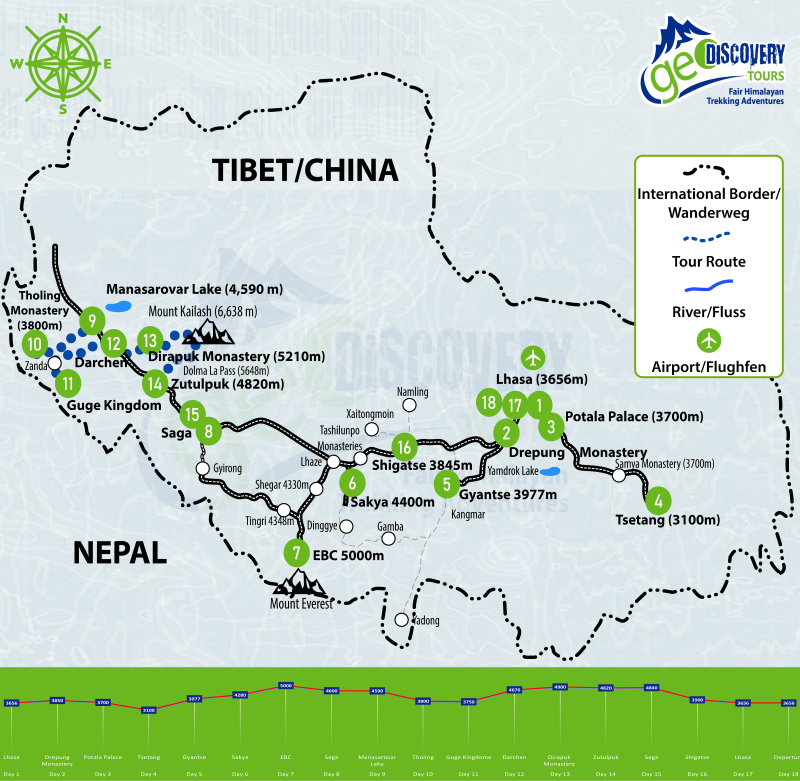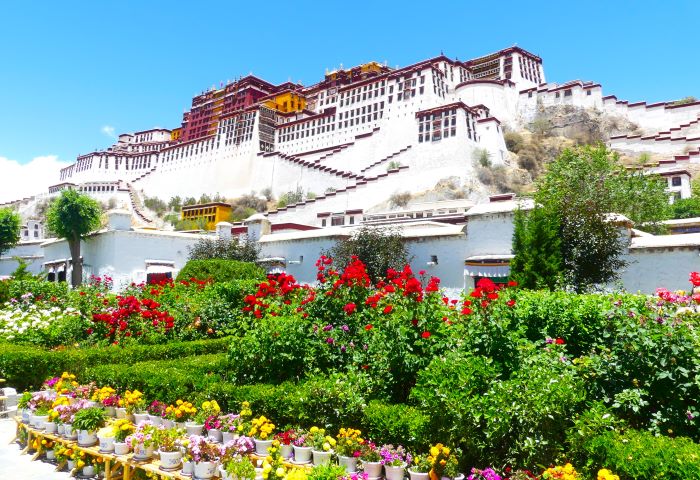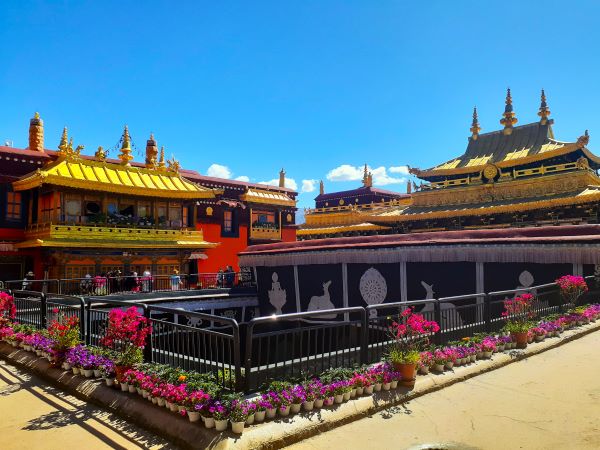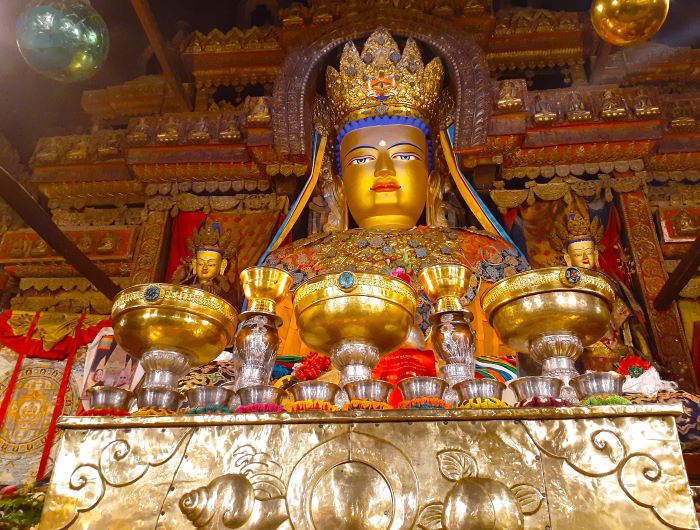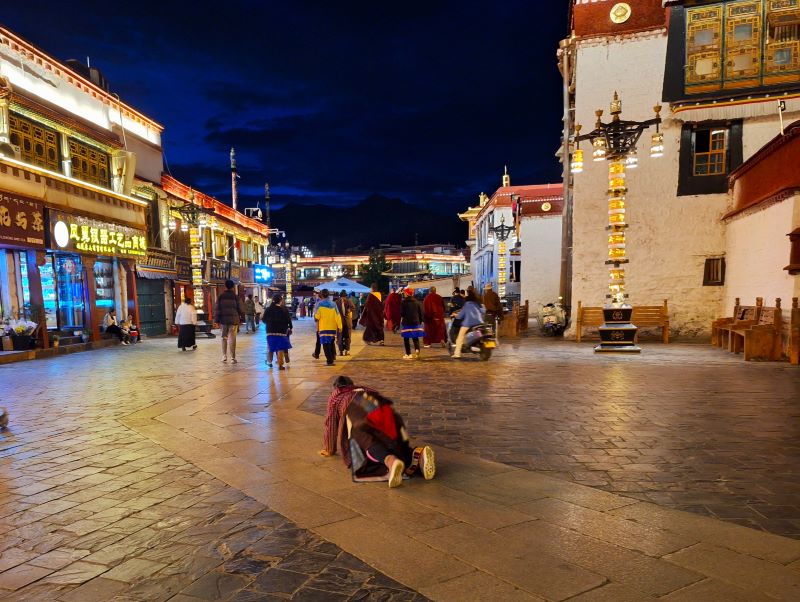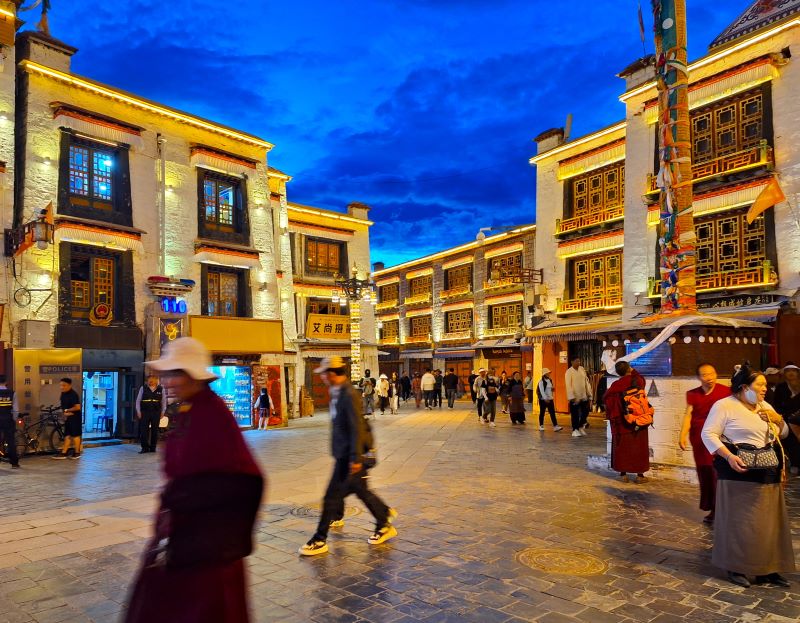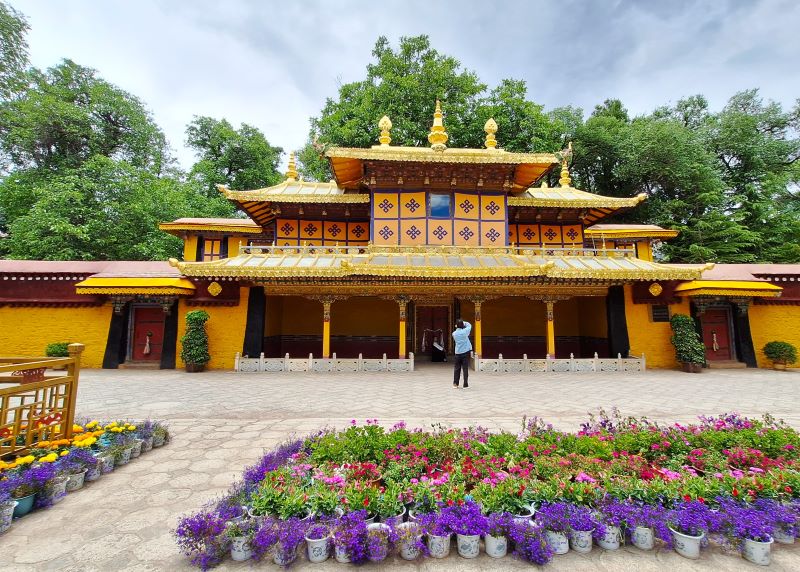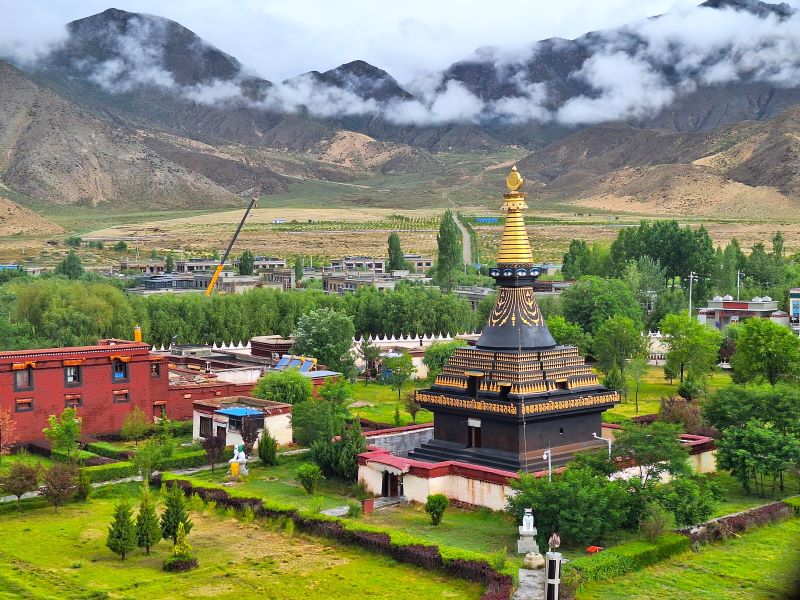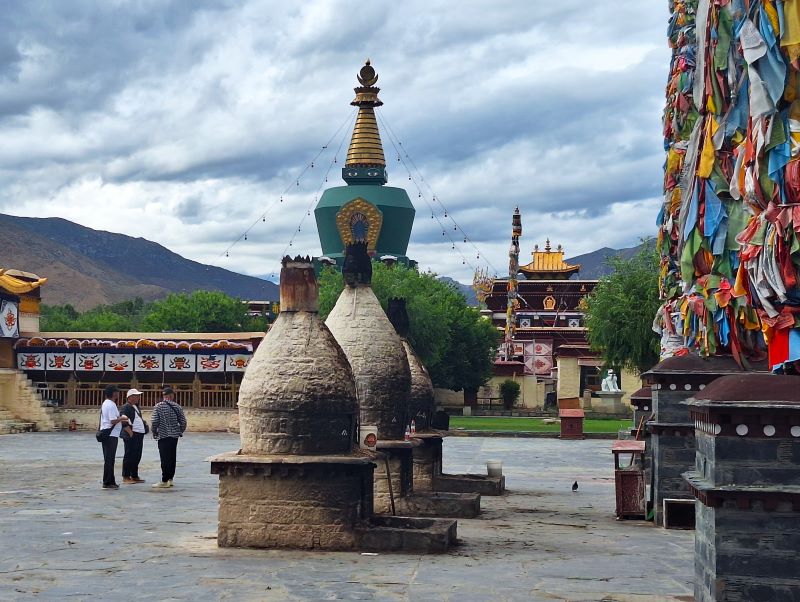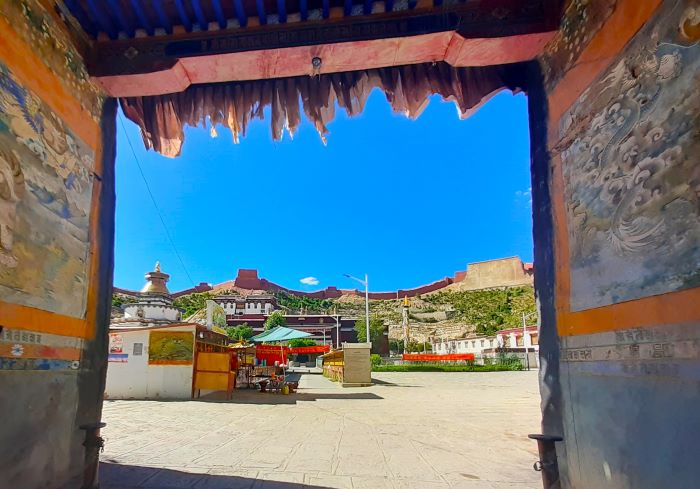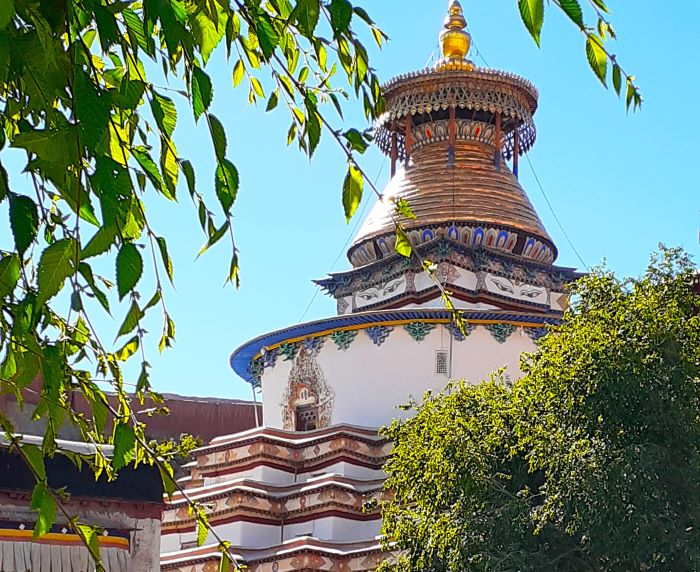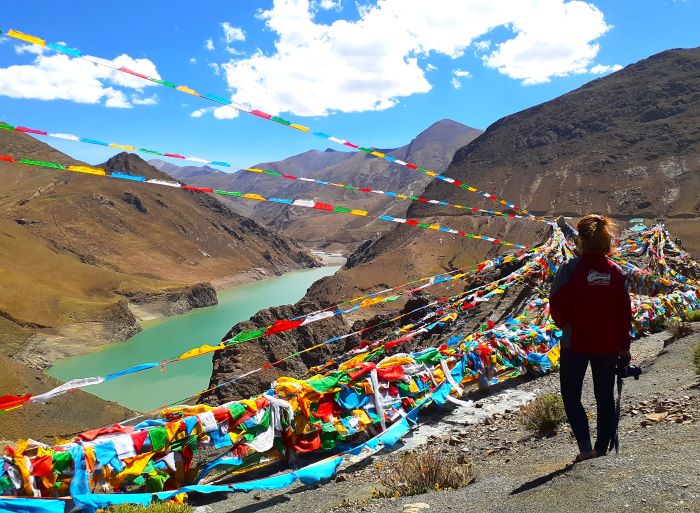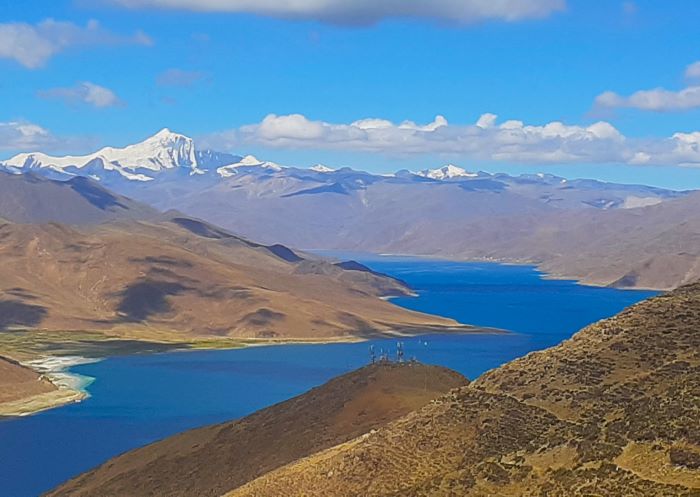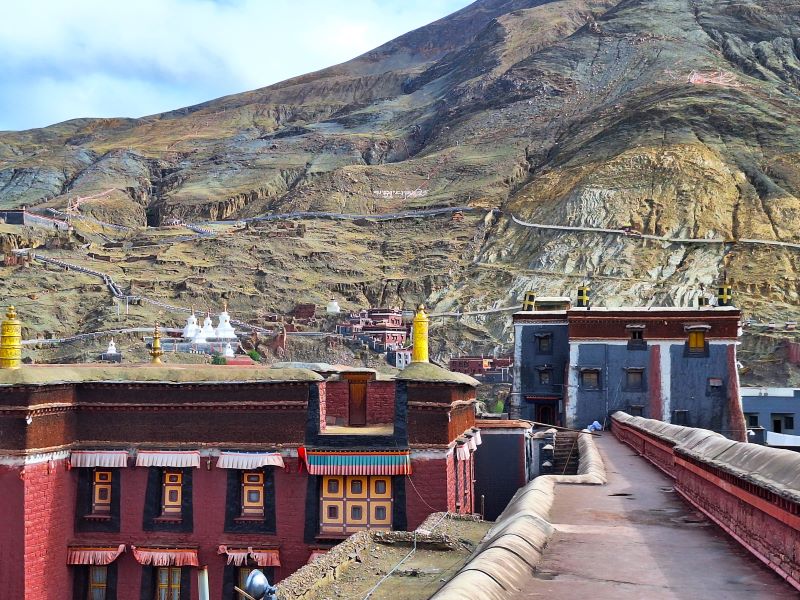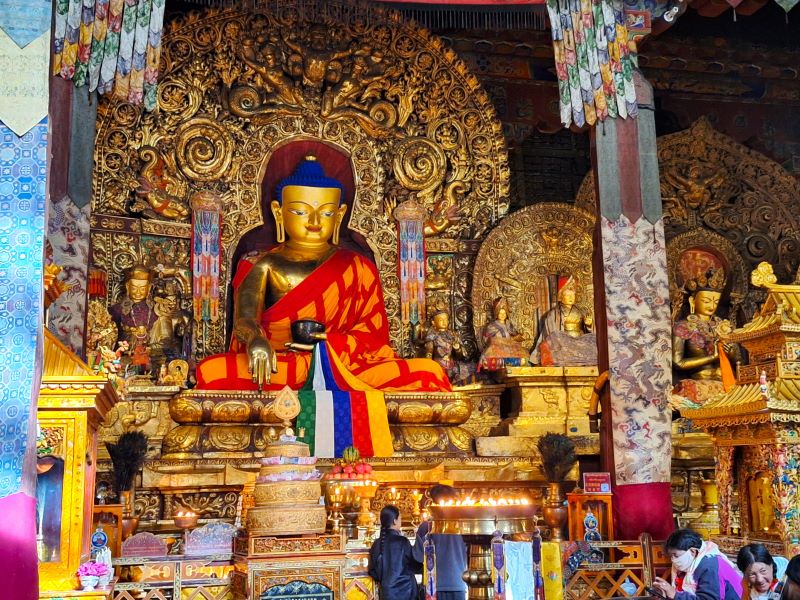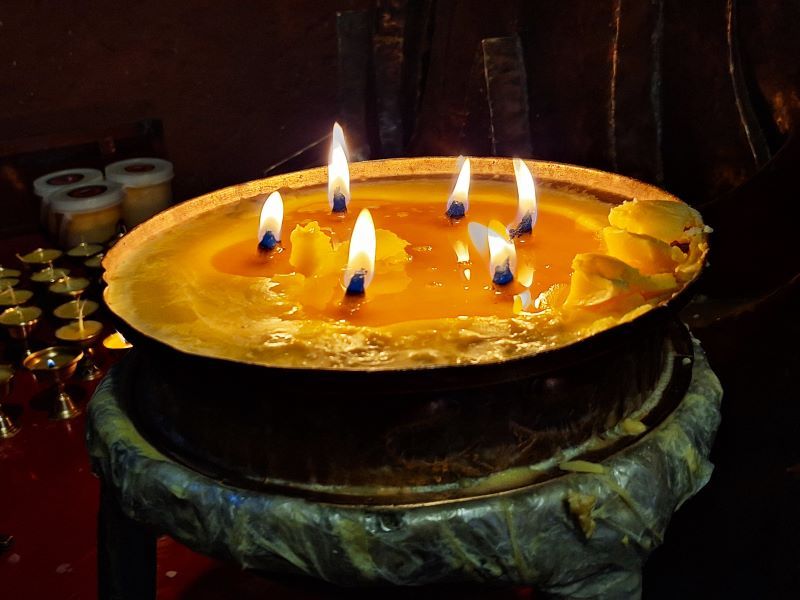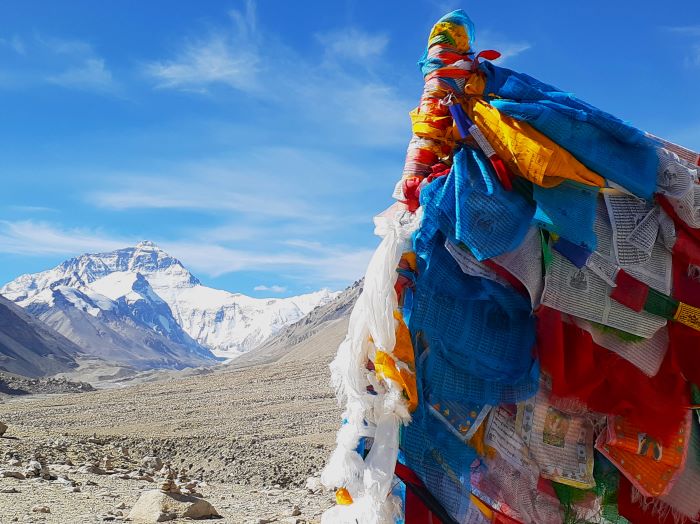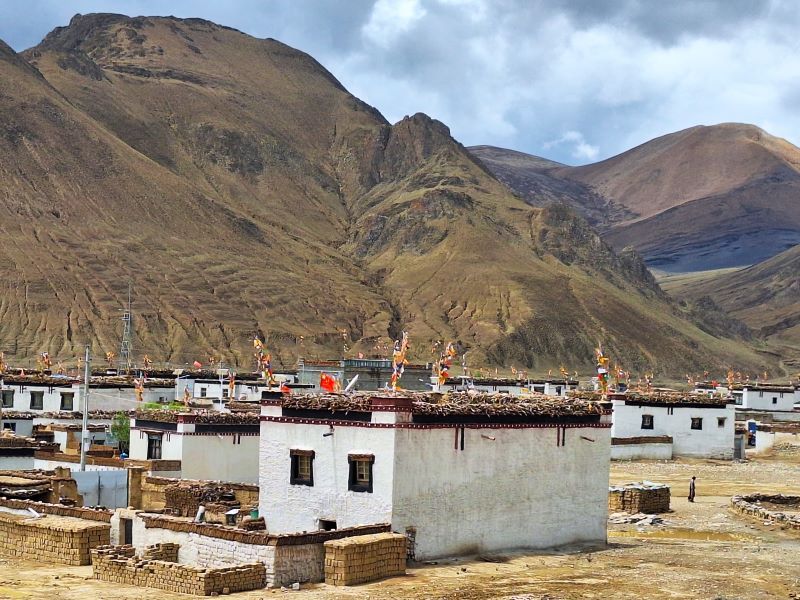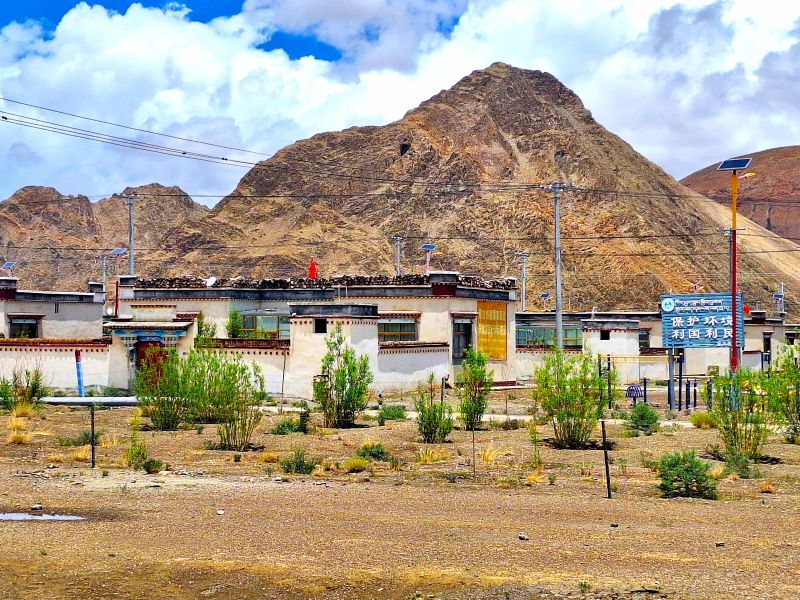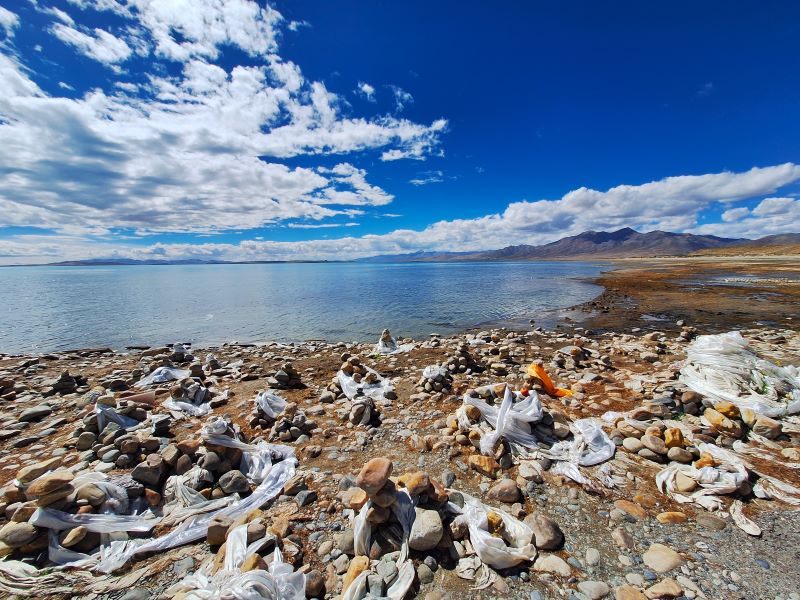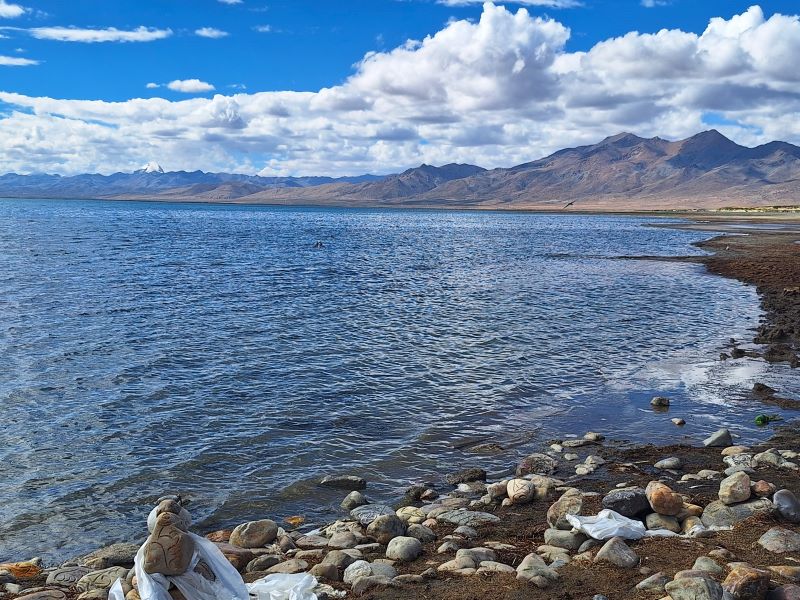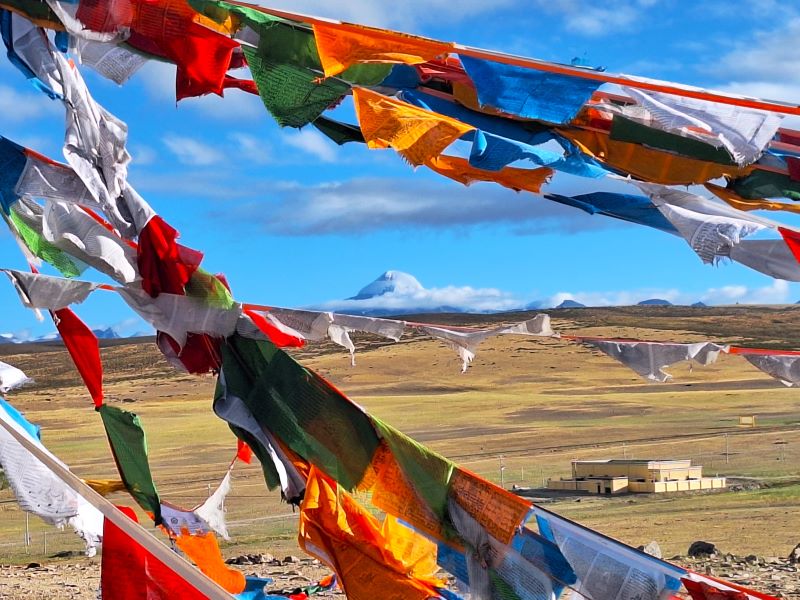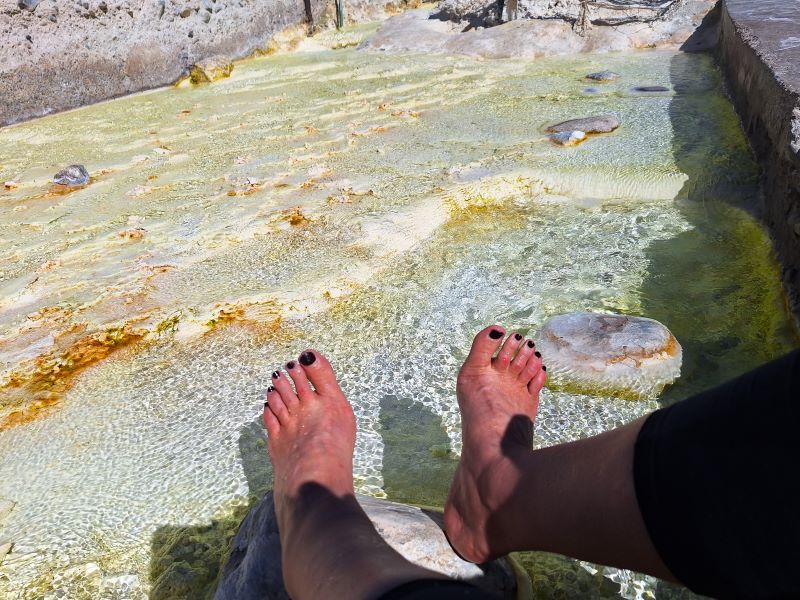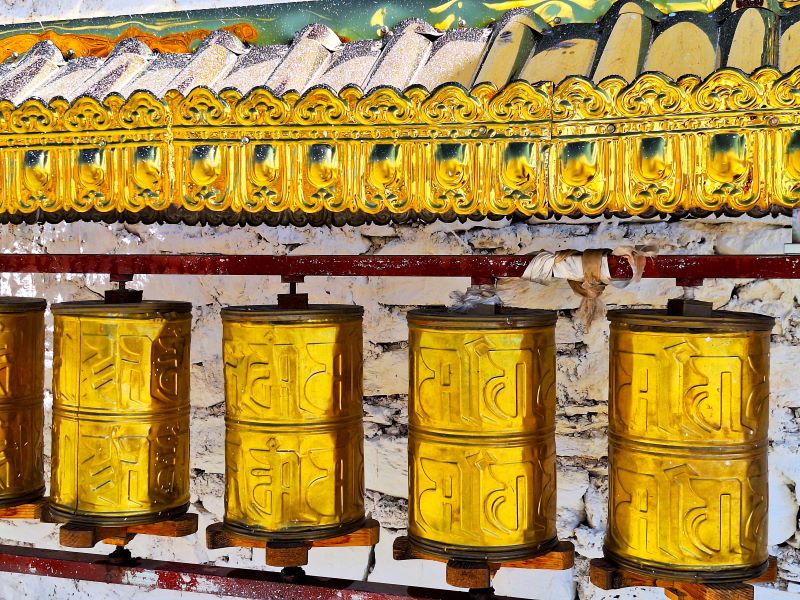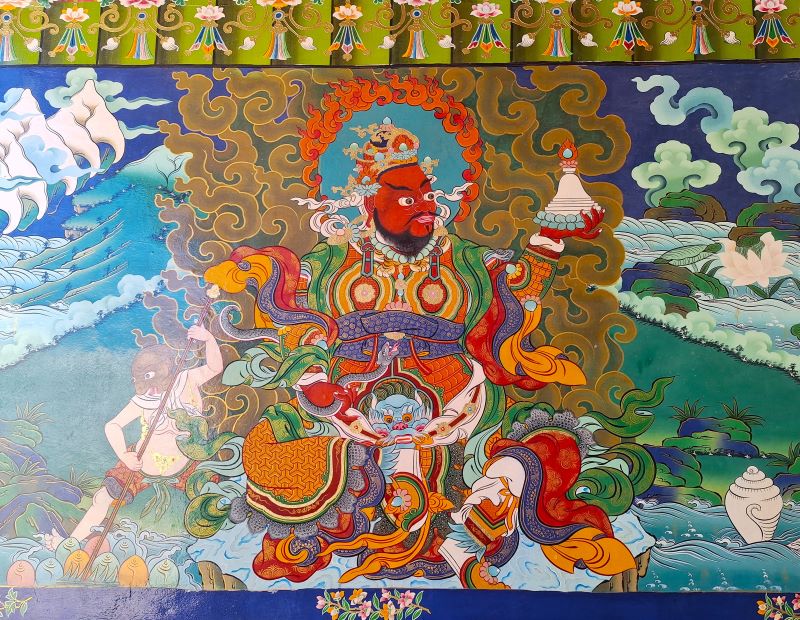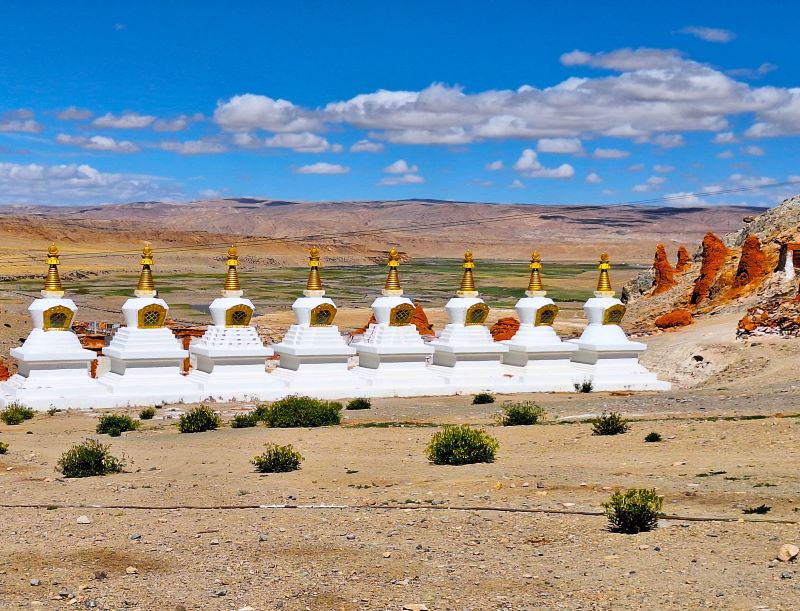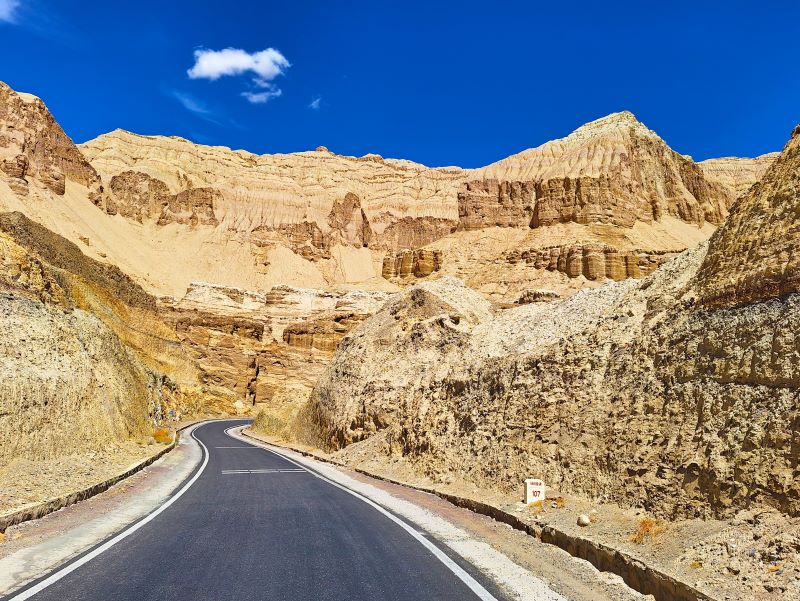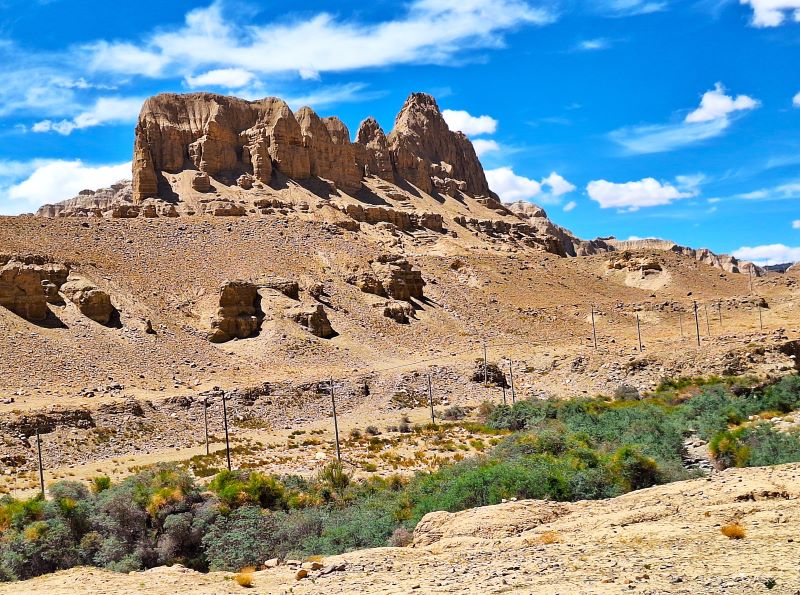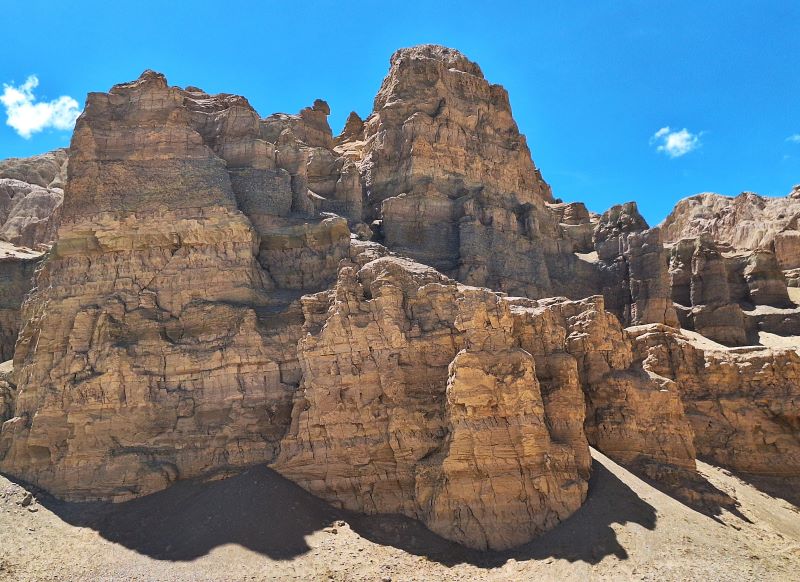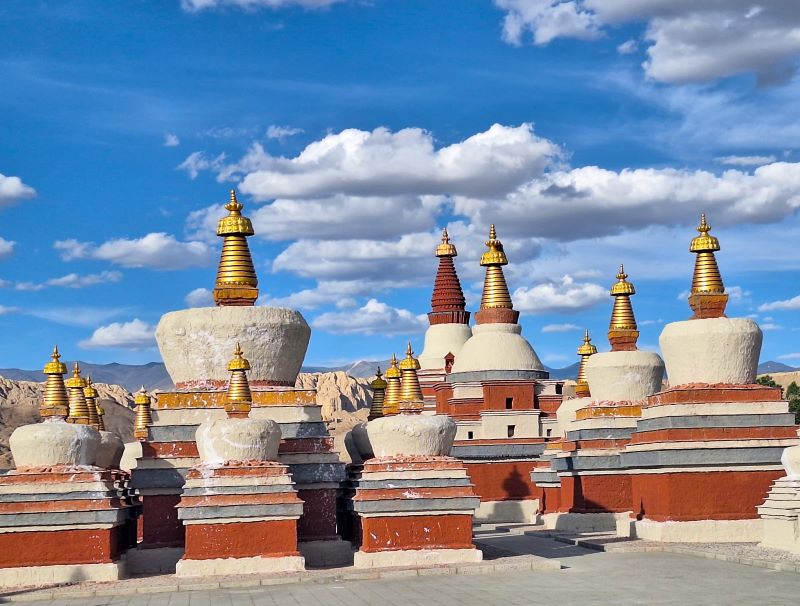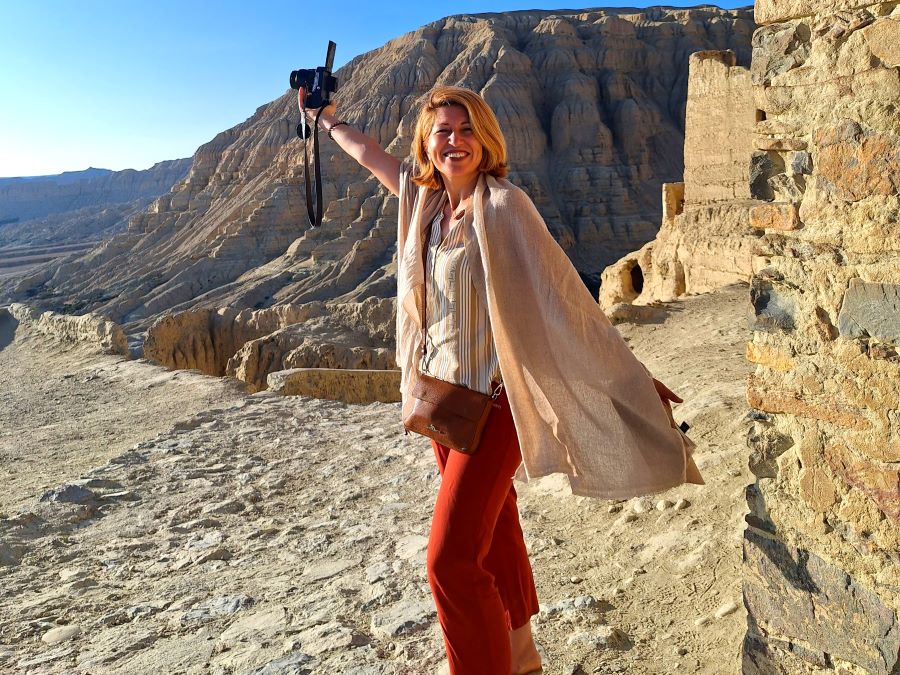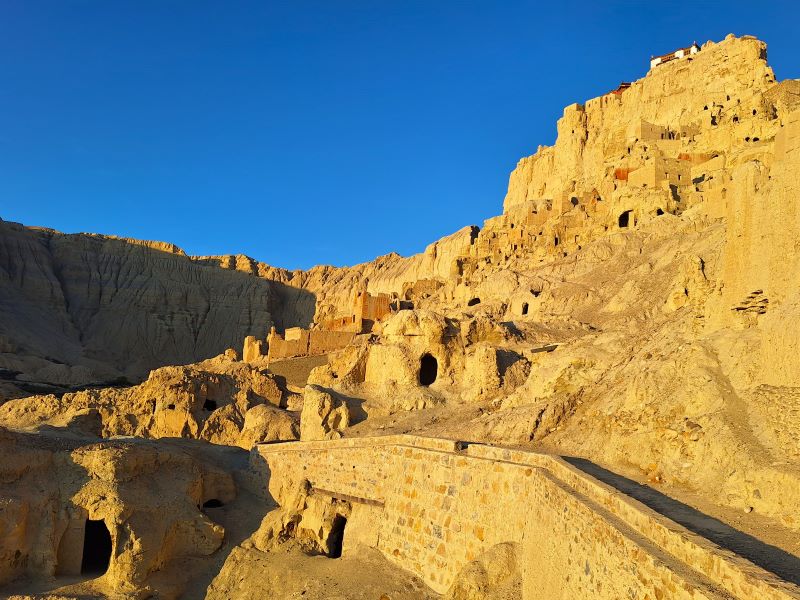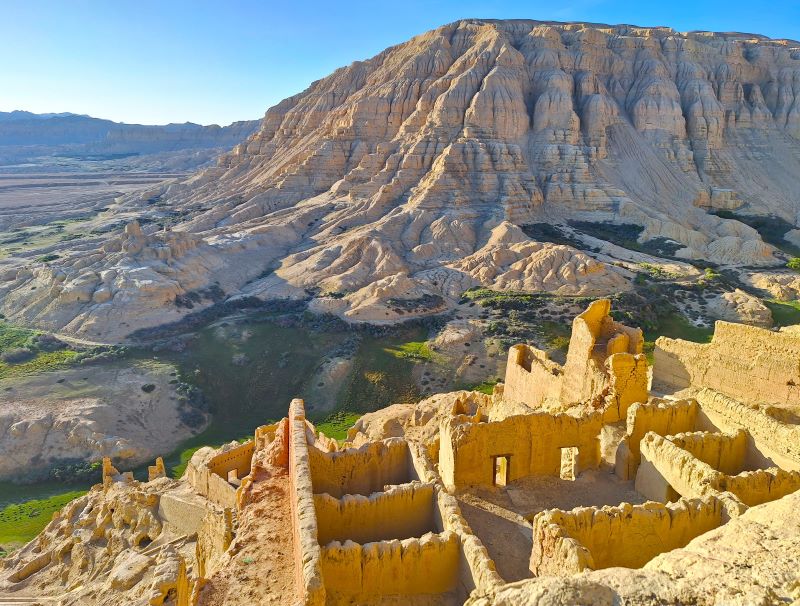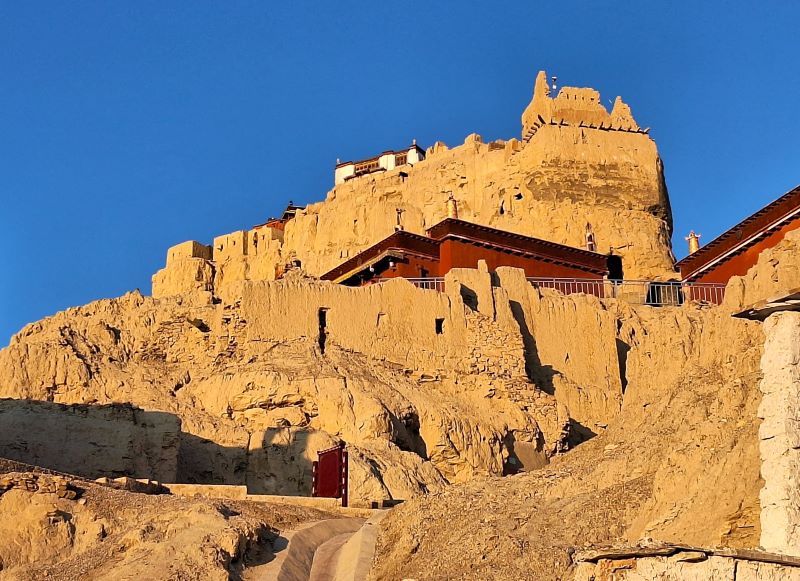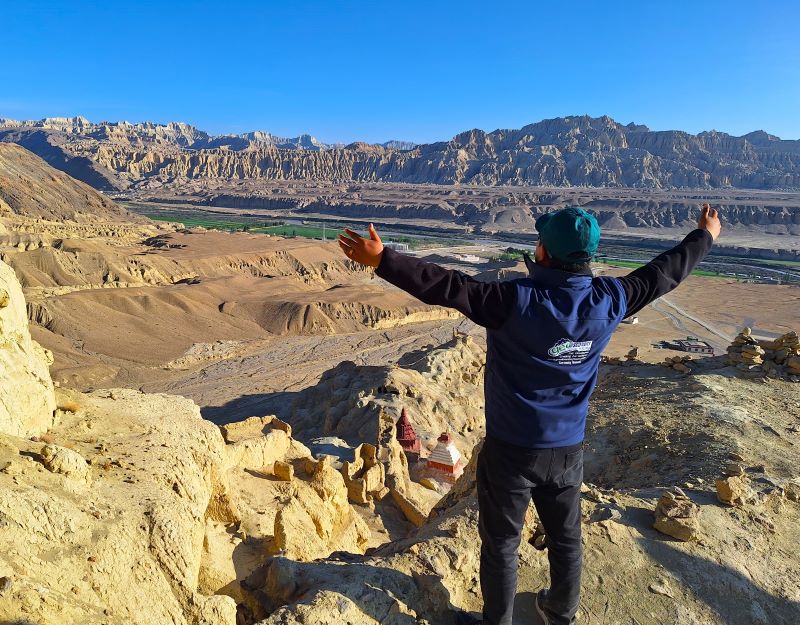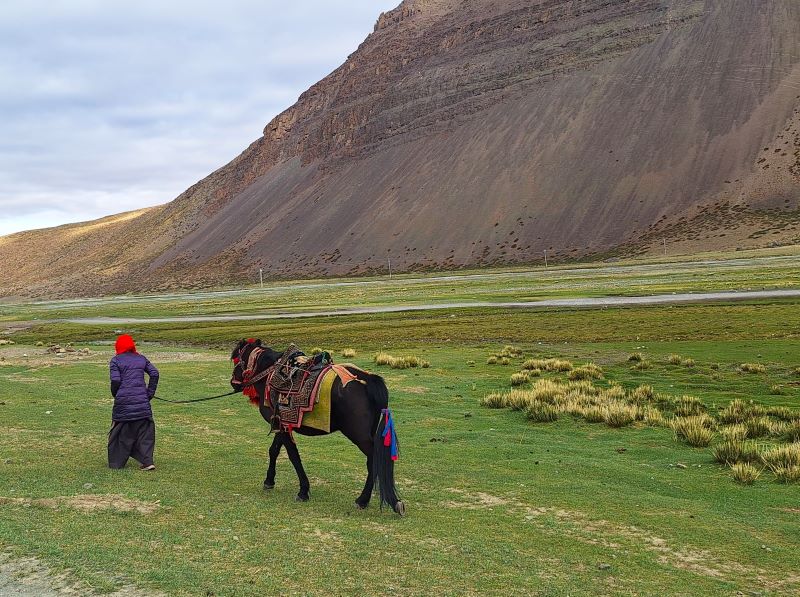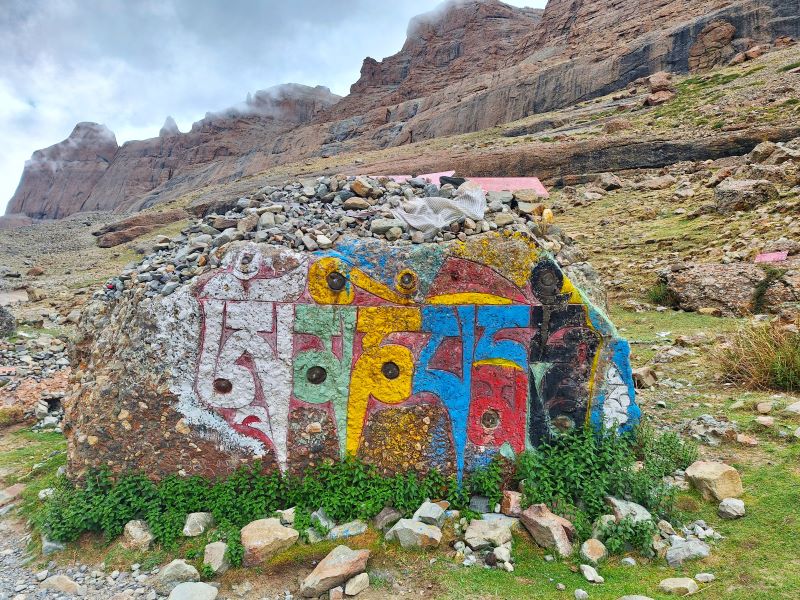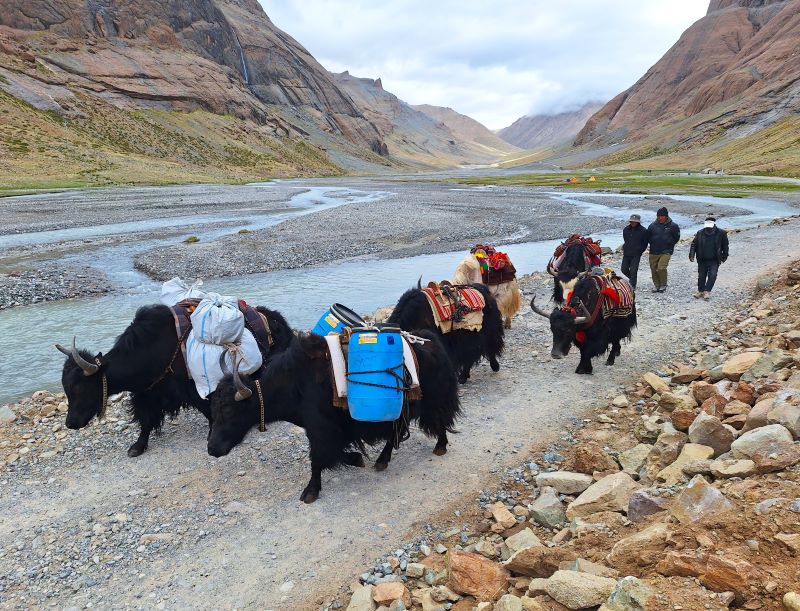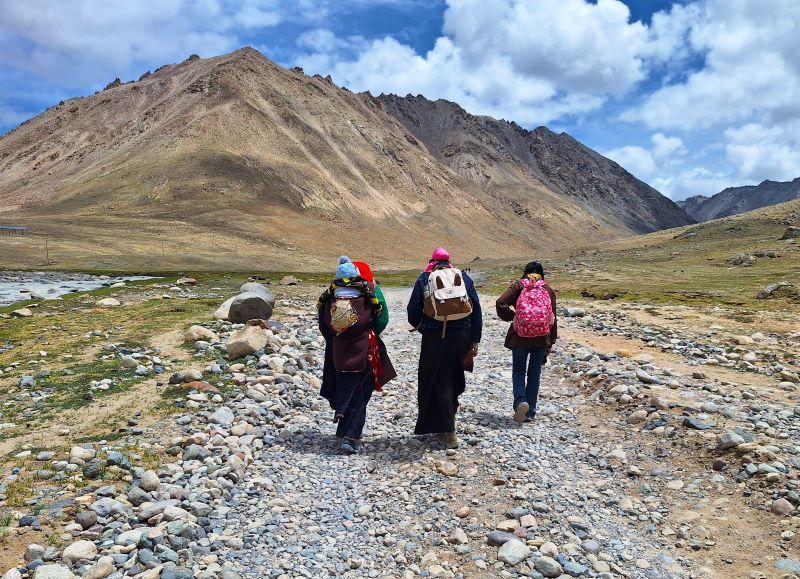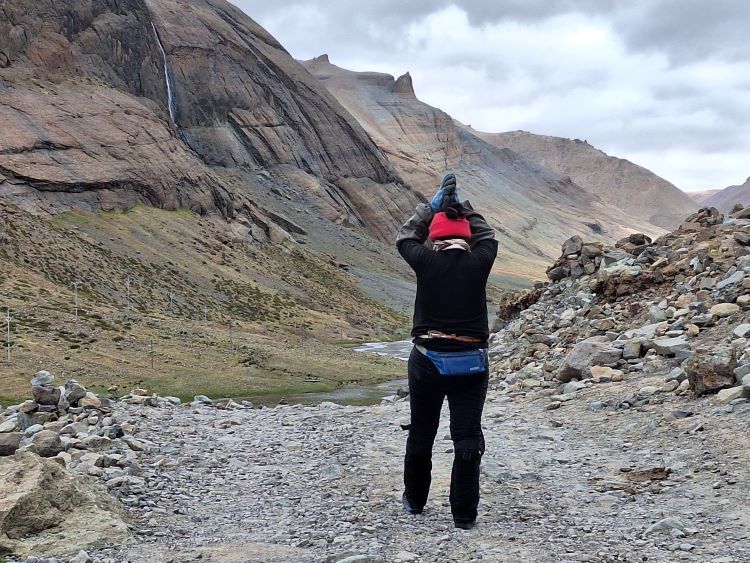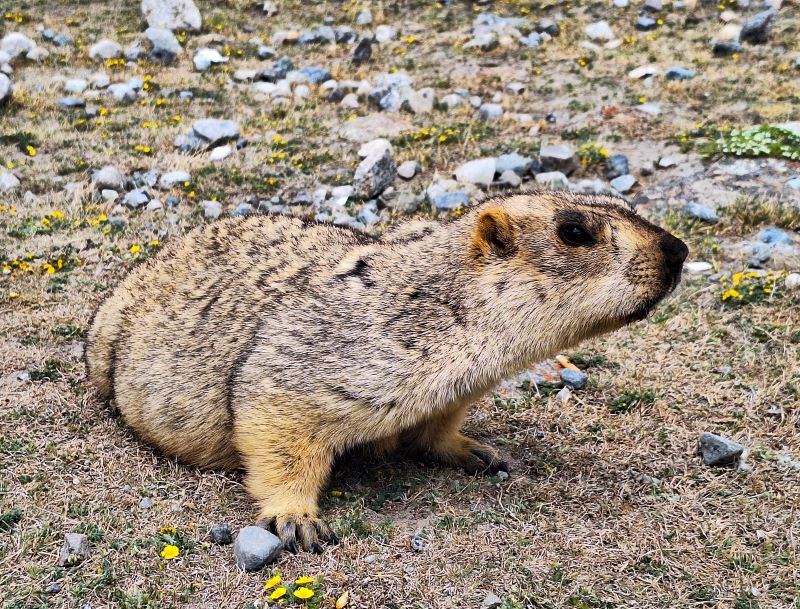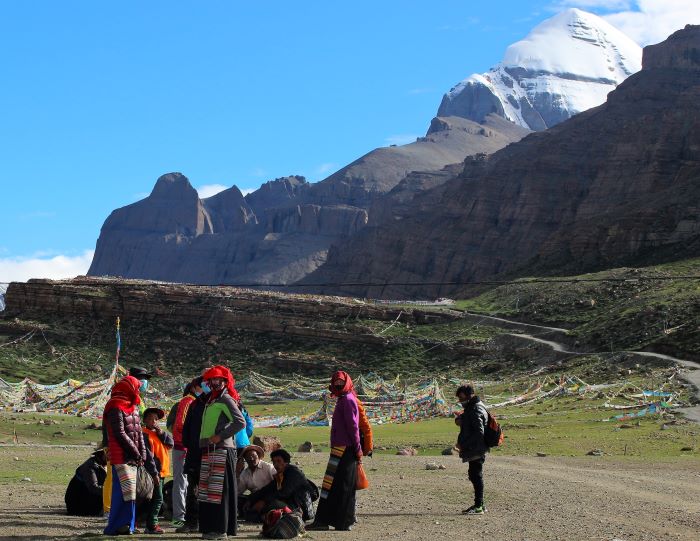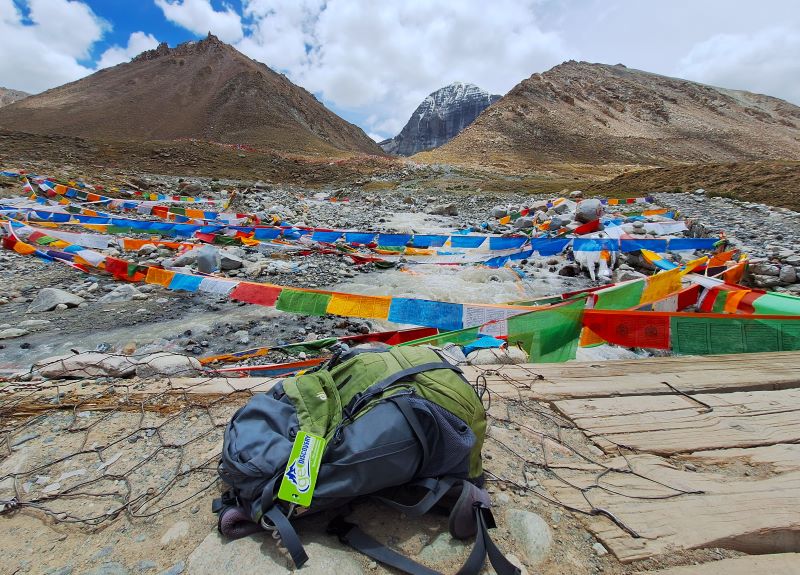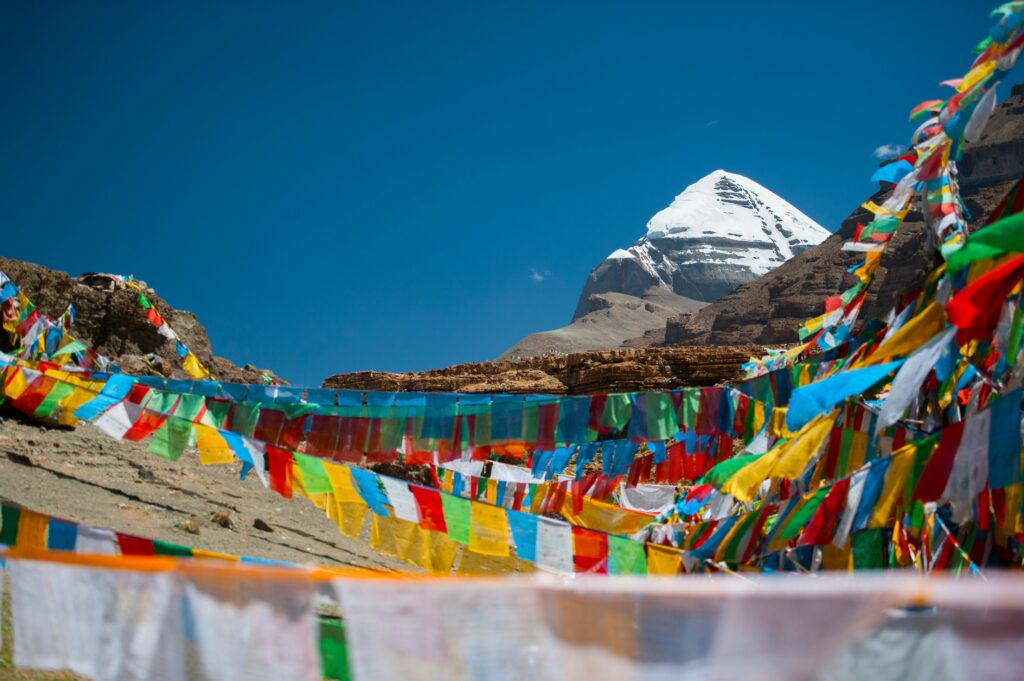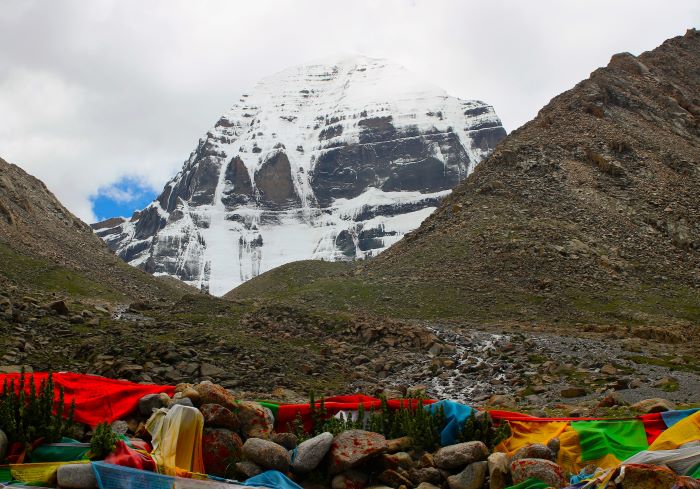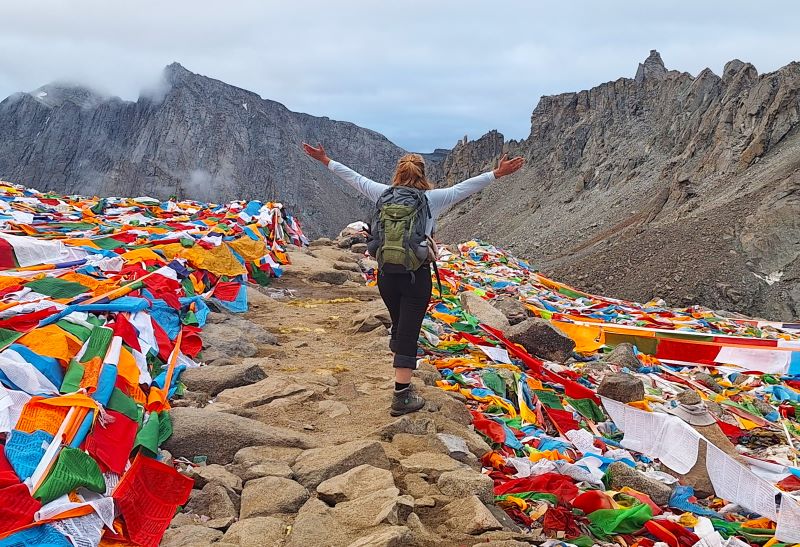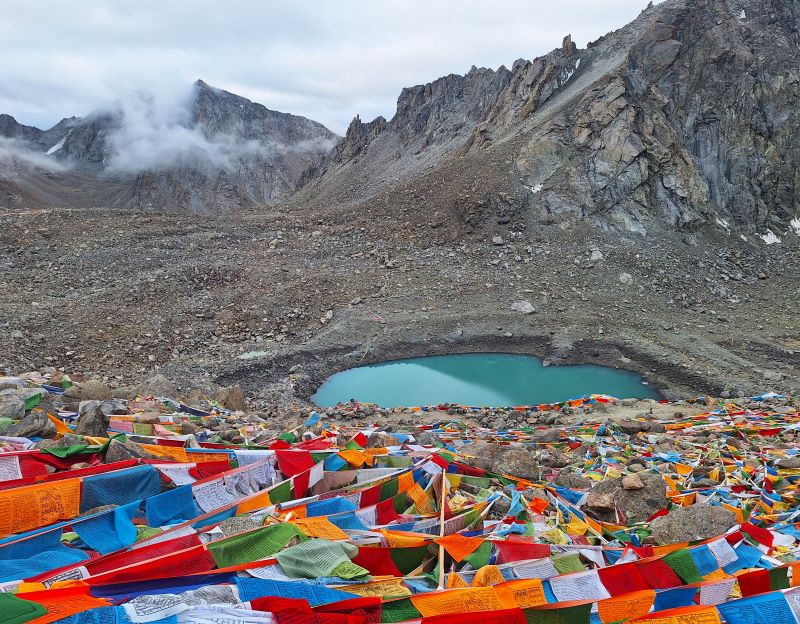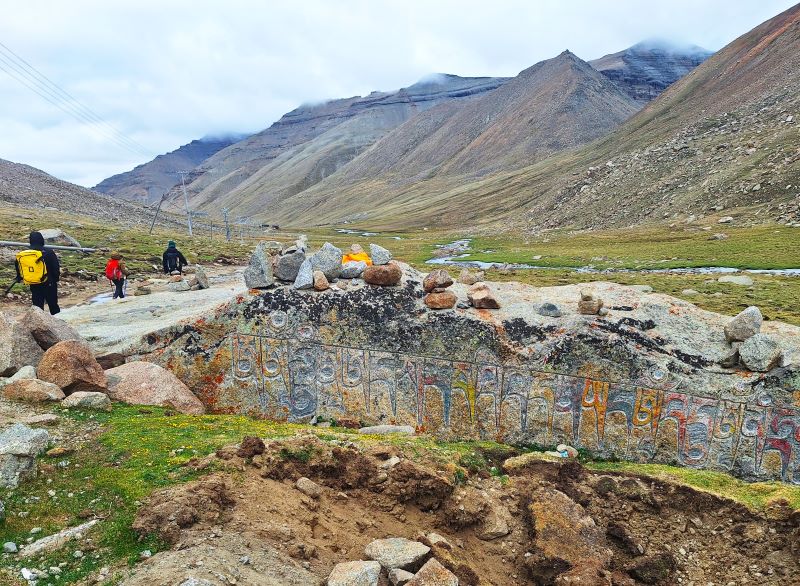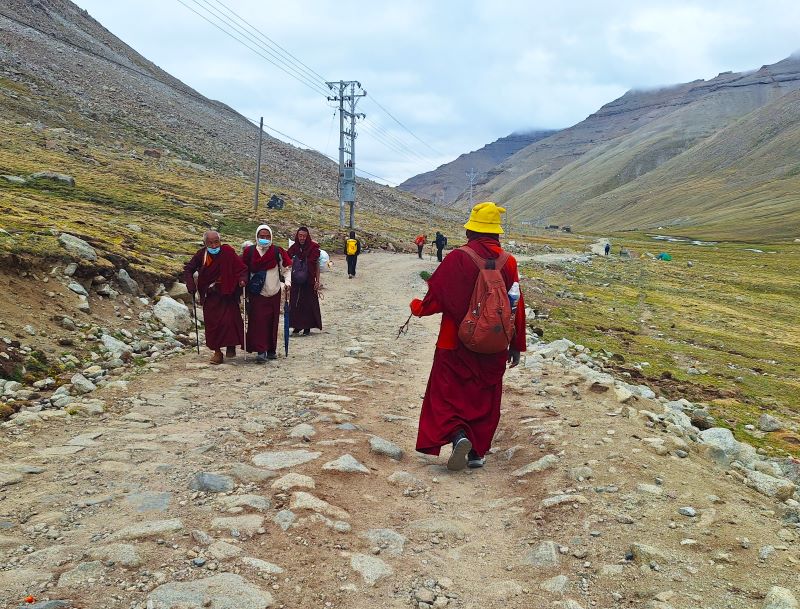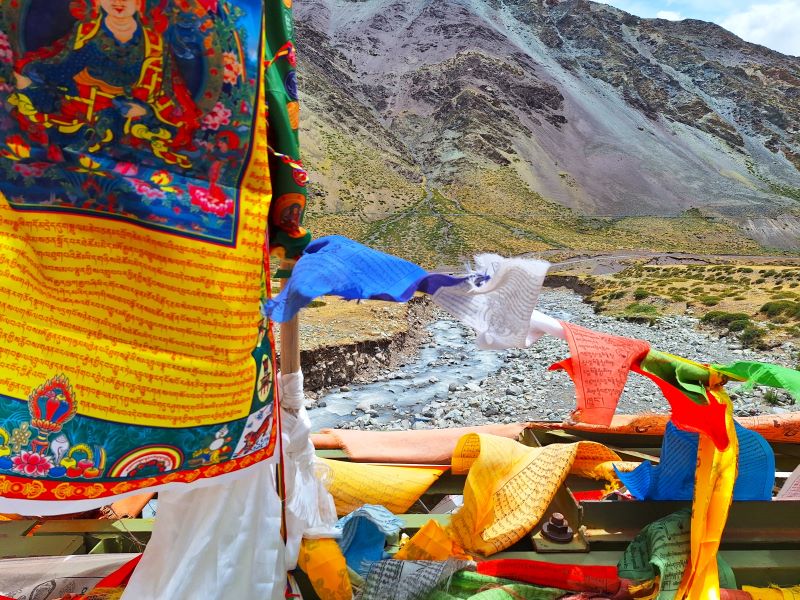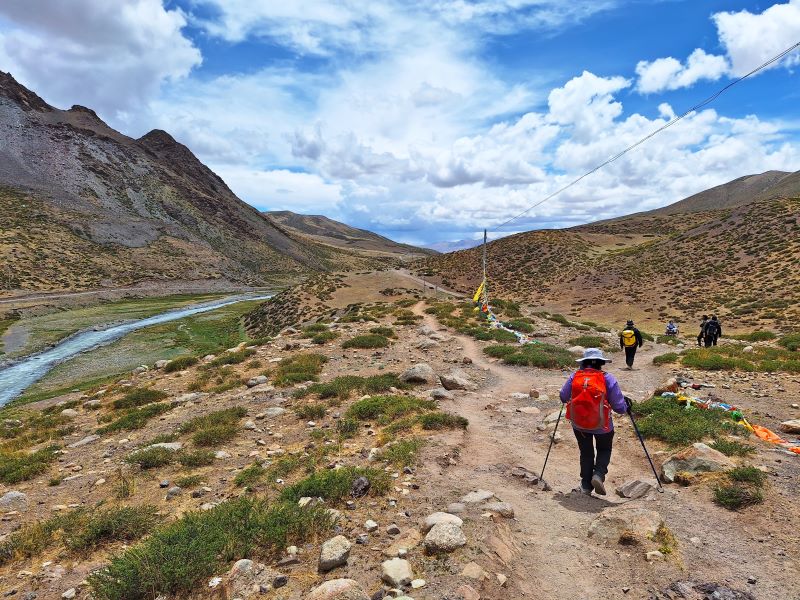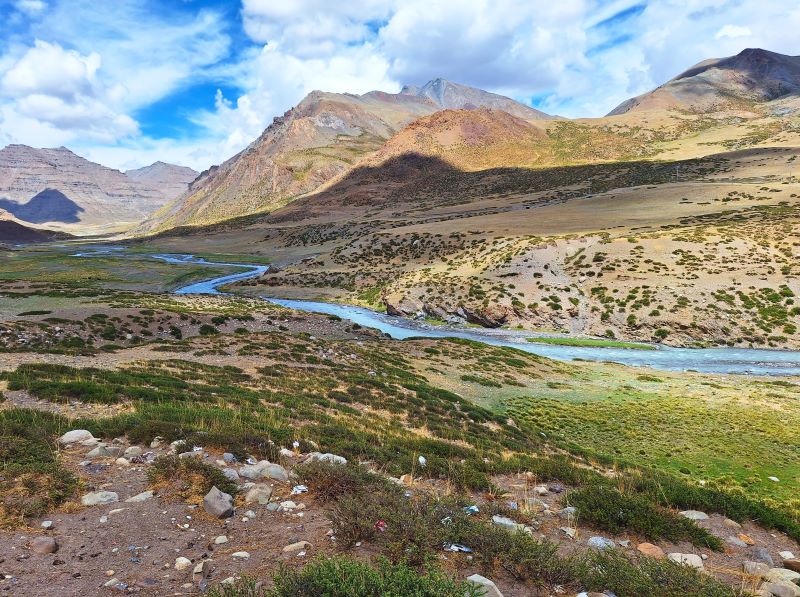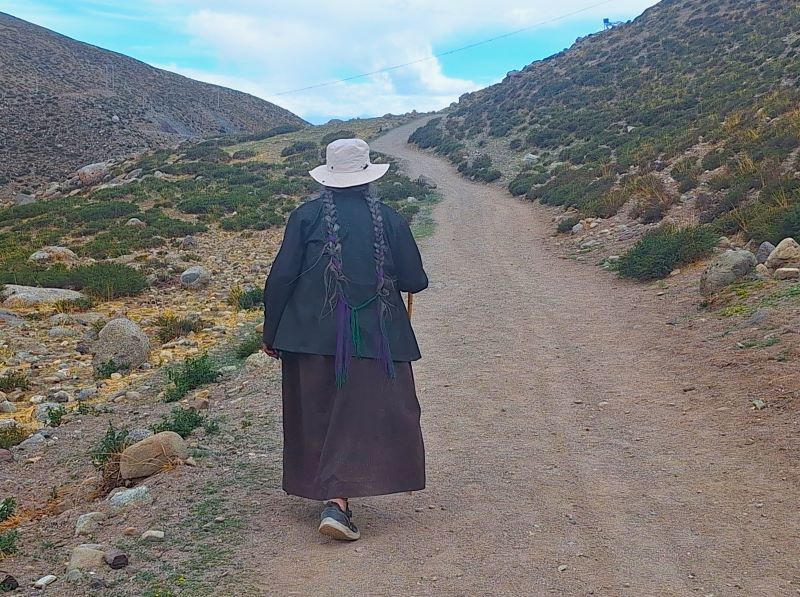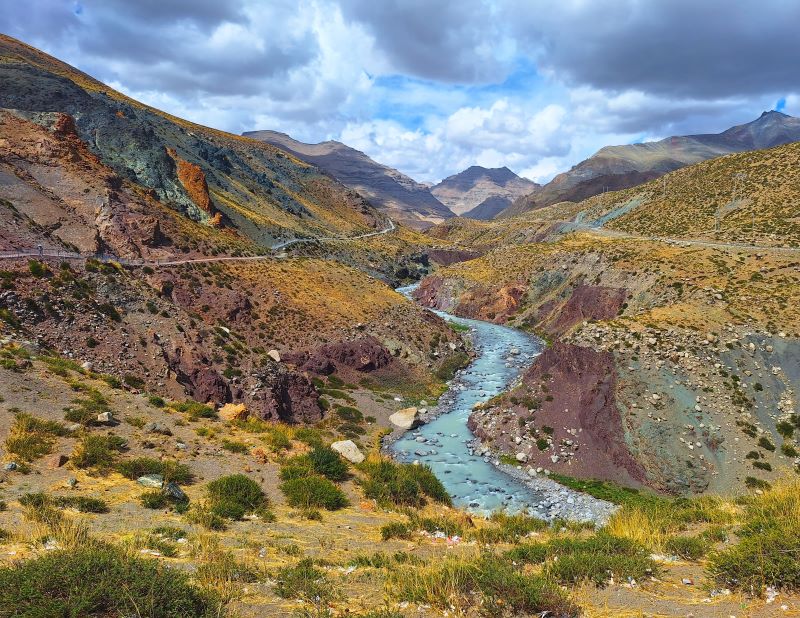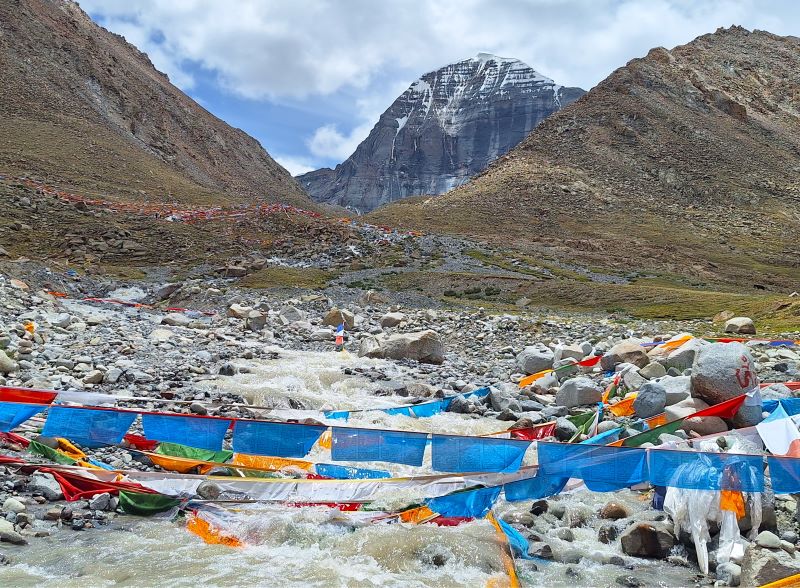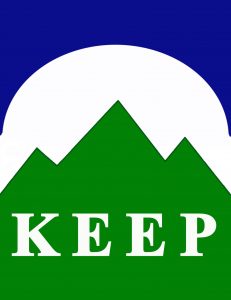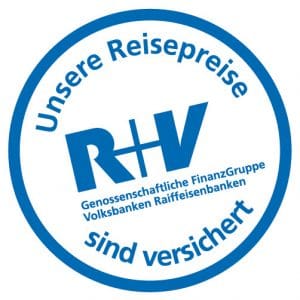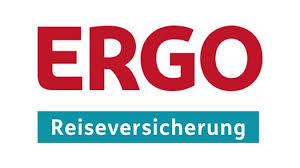Kailash Pilgrimage with Manasarovar Lake and Guge Kingdom
- Description
- Gallery
- Trip itenerary
- Trip dates, prices and services
- Important travel information
- Request Book
Our Kailash trekking tour with the Guge Kingdom is one of the most impressive pilgrimages and cultural journeys in Tibet. Join us to experience the most significant places in Tibet, such as Mount Kailash, Lake Manasarovar, the Mount Everest Base Camp, the historical sites and structures in Lhasa, and the mystical Guge Kingdom.
Mount Kailash is considered the holiest mountain and the center of the cosmos. It is the source of four major rivers in Asia and a destination for countless pilgrims from various religions, including Hinduism, Tibetan Buddhism, Jainism, and Bön. The journey begins with a sightseeing tour of the Tibetan capital, Lhasa. The majestic Potala Palace, the Jokhang Temple, the Drepung and Sera Monasteries, and a stroll around the bustling Barkhor Square in Lhasa will leave you in awe.
We will then travel to Shigatse, where we will enjoy sights such as the turquoise Yamdrok Lake, the Pelkor Chode and Kumbum Stupa in Gyantse, and the prestigious Tashilhunpo Monastery. Later, we will continue our journey to Tingri to visit the Everest Base Camp (5000 m) and the Rongbuk Monastery. Along the way, we will be treated to magnificent views of the Himalayas and Trans-Himalayan panorama dominated by peaks like Shishapangma (8,027m) and many others. We will head further west to the Ngari Prefecture to admire the sacred Lake Manasarovar and then travel to the ancient Guge Kingdom with its myths and breathtaking landscapes.
Well acclimatized, we will embark on our pilgrimage (Kora) around the sacred Mount Kailash. Glittering snow and colorful prayer flags fluttering in the wind will guide us to the 5,630 m high Drolma La Pass, filling us with a sense of great joy upon reaching it.
Hiking experience as well as altitude tolerance and surefootedness are prerequisites for this tour.
Day 1: Arrival in Lhasa (3,656 m) – briefing and welcome dinner
During the flight to Lhasa you will have a great panoramic view of the snow-capped Himalayas. At the airport you will be greeted by our local Tibetan tour guide and driver and transferred to the hotel. The journey from the airport to downtown Lhasa takes approximately 1½ hours. After arriving at the hotel, take time to rest to get used to the altitude (3600m). It is helpful to take it easy for the first few days and make sure you drink enough fluids. From now on you will always have a bottle of mineral water within reach. In the evening a traditional welcome dinner awaits you. Overnight stay in the hotel, (D).
Day 2: In Lhasa (3,656 m) – Drepung Monastery, Sera Monastery – Visit to Barkhor Street – Evening walk on Barkhor Street
Today’s first attraction is a visit to Drepung Monastery, the largest and most influential Tibetan monastery, once home to more than 10,000 monks. The Dalai Lama was once one of the residents. After lunch, visit another famous monastery, Sera Monastery, founded in 1419 by Tsongkapa’s disciple Jamchen Choeje. A particularly impressive experience is the Buddhist scriptures discussed loudly and with many gestures by monks and novices. You can attend the debates from Monday to Saturday between 3:00 p.m. and 5:00 p.m. Lhasa’s Old Town, Barkhor Street, considered the “Heart of Lhasa”, is home to the most famous pilgrimage route and busiest bazaar in Lhasa. Originally, Bark-hor Road was the only way to circumnavigate Jokhang Monastery and was called the “Sacred Road” by local Tibetans. It has now gradually expanded to include the large, historic district around Jokhang Temple. With a total length of about 1000 meters, this ring road has 35 side streets and alleys, preserving the traditional appearance and lifestyle of the ancient city of Lhasa. Here we take you on a journey through time and catch glimpses of life centuries or even a millennium ago. In the evening you should definitely visit the street again, which is not far from your hotel, as it creates a very mystical atmosphere, especially in the glow of the light. Overnight stay in the hotel, (B).
Day 3: In Lhasa (3,656 m) – Potala Palace, Jokhang Temple, Tibet Museum
In the morning, your guide will pick you up from the hotel and accompany you to the famous Potala Palace, the symbol of Tibet and a masterpiece of Tibetan architecture. The palace was first built in the 7th century by the 33rd King Songtsen Gangpo and later rebuilt by the 5th Dalai Lama in the 17th century. Today the Potala is a museum and world heritage site. Please note that photography is not permitted inside the Potala Palace. We recommend having your passport ready at the entrance. In the afternoon we visit the Jokhang Temple in the historical center of Lhasa city. Jokhang Temple is one of the holiest temples in all of Tibet and has always been full of local pilgrims. Afterwards we visit the Tibet Museum. It features “countless historical and cultural relics, Buddhist figures, ancient Tibetan books and records, and folk crafts. Overnight stay in the hotel, (B).
Day 4: Lhasa to Tsetang – Samye Monastery (3540m) – Lhasa – 360km / approx. 4 hours drive
Today we drive along the Yarlung Tsangpo, as the mighty Brahmaputra is called in its Tibetan upper reaches, to Samye Monastery. On the way we can admire the extraordinary sand dunes, the high mountain meadows and the many branches of the river. In Tsetang we first get permission for the further tour and then visit one of the most beautiful monasteries in Tibet. The Samye Monastery is the first Buddhist monastery in Tibet, built in the 8th century as a mandala temple and monastery complex, approximately 60 km southeast of Lhasa. In the afternoon we drive back to Lhasa. Overnight stay in the hotel, (B).
Day 5: Lhasa – Yamdrok Tso – Gyantse (3,977m) 270 km / 6 hours drive
Today we have an early breakfast and continue to Gyantse, which is 290 km from Lhasa. The road skirts Lake Yamdrok, a vast, blue-reflecting body of water 4,300 meters above sea level, and then climbs to the 5,010-meter-high Karo La (pass), a spectacular step between the glaciers. On the way we visit the Samding Monastery, which rises into the water about 90 meters above Lake Yamdrok at the end of a narrow peninsula. Samding Gompa was destroyed after 1959 but is currently being restored. Samding is the seat of Dorje Pakmo, the consort of the wrathful deity Heruka, the highest female incarnation in Tibet and the third highest person in the Lamaist hierarchy after the Dalai Lama and the Panchen Lama. After almost three hours we reach the Kamba Pass (4,700 m). From here we enjoy a beautiful view of the sacred lake Yamdrok Tso and its perfect turquoise color. We continue along the lake and after an hour we reach the town of Nangartse (4,300 m), where we take a break for lunch. In the afternoon the path takes us further up to Korala, which is 5,045 meters above sea level. From up here we can marvel at the spectacular Nojin Kangsang Glacier (7,206 meters). Before we reach Gyantse, we see another reservoir with turquoise water, embedded in a beautiful landscape in a fascinating valley. After about an hour we reach Gyantse, with an old city wall dominated by a fortress from 1390. The original fortress is believed to have been built by Pelkhortsen, son of the anti-Buddhist King Langdarma, who ruled between 838 and 841. The walls were built in 1268 after the rise of the Sakyapa sect. Gyantse is known as the “City of Heroes” because the city put up strong resistance against the overwhelming strength of the British Tibet Expedition led by Francis Younghusband in 1903-1904. Another highlight of the city is the Chöde Monastery with its huge “Kumbum”, a four-story, walk-in chorten with 108 chapels and countless murals. Overnight stay in the hotel, (B).
Day 6: Drive from Gyantse via Shigatse to Sakya, Shalu and Tashilunpo monasteries – 240km / 5 hours
Today we first drive to Shigatse, the agricultural center of Tibet. On the way we stop at Shalu Monastery, which houses the oldest surviving murals in Tibet. Arriving in Shigatse, we visit the Tashilumpo Monastery – the seat of the Panchen Lama, who is considered the reincarnation of the Buddha of endless enlightenment. Built in 1447 by the first Dalai Lama, this monastery houses interesting items such as the relics of Shakyamuni, the Hall of Maitreya and an outstanding collection of gifts and statues. We continue to Sakya and visit the Sakya Monastery, another very important Tibetan Buddhist monastery. It is the parent and main monastery of the Sakya school of the same name and was the political center of Tibet in the second half of the 13th century and the first half of the 14th century. Overnight stay in the hotel, (F).
Day 7: Sakya – Xegar to Everest Base Camp (5,000 m) – 220km / approx. 5 hours
After breakfast we set off for Xegar. The town, which has 3,000 inhabitants, is the center of this remote region of Tibet and serves as a starting point for expeditions to Mount Everest and other peaks. As the journey continues we reach Tingri. When the weather is good, we can already see Mount Everest (8,849 m) on the horizon. The journey takes us over the Gyatso La Pass (5,248 m) and the Pang La Pass (5,120 m) to the new Mount Everest Base Camp (5,000 m). Here you have an excellent view of the gigantic north face of Everest. Overnight stay in a simple hotel, (B).
Day 8: Everest Base Camp, Rongbuk Monastery – Drive via Pelkhu Lake to Saga (4,840 m) – 347 km and 6 to 7 hours drive
We get up at sunrise to admire the giant in the morning light. After breakfast we visit the Rongbuk Monastery and continue on the Friendship Highway to the deep blue Pelkhu Tso (lake). On a short hike around the lake we enjoy the fresh wind and the magic of the landscape. Continuing along the main Himalayan chain, we pass some typical Tibetan villages and reach Saga (4,600 m). With a little luck we will have a view of the peaks of Shishapangma (8,046 m), Langtang (7,227 m) and Gaurishanker (7,134 m). Overnight stay in the hotel, (B).
Day 9: Drive to Manasarovar Lake (4,590 m), 500 km and 7 to 8 hours drive
Today we have a longer journey of more than 500 km ahead of us. We start towards Paryang, which is almost 450 km from Saga. From Paryang we make our way across a plain to Lake Manasarovar, just 30 km south of Mount Kailash. As we approach this beautifully situated sacred lake, the historic Chiu Monastery becomes visible on the northwest shore of the lake. From this wonderful vantage point, with a bit of luck, we can catch our first magnificent view of the majestic Mount Kailash. Finally we are close to him! Optionally we can drive around Manasarovar Lake. Overnight stay in a simple guesthouse, (B).
Day 10: Manasarovar Lake (4,590 m) – Tirthapuri Monastery, hot springs – Guge Kingdom – Tholing Monastery – 290km / approx. 7 hours drive
Very early in the morning we drive to the viewpoint of Mt. Kailash and admire the holy giant in the morning light. After breakfast we set off towards Tirthapuri and leave the unique landscape of Lake Manasarovar with a view of Gurla Mandhata (7,694 m) behind us. We drive along the Sutlej Gorge and through the Garuda Valley to Guge. The extraordinary landscape of Zanda will captivate and enchant us from afar. On the way there, with a bit of luck in the weather, we have a unique view over the gorge and all the way to the Indian Himalayas on the horizon with the holy mountain Nanda Devi (7,816 m), the highest mountain in India. We make a short stop in Thirthapuri. After Mount Kailash and Lake Manasarovar, Tirtha-puri is considered the third most important Buddhist pilgrimage site in western Tibet. Located northwest of Mount Kailash and on the north bank of the Sutlej River, Tirthapuri (also called Zhadaburi, 4,310 m) is famous for its sacred hot springs and Guru Rinpoche Monastery (Tirthapu-ri Monastery). In the small village of Zanda (3,800 m) is the Tholing Monastery, one of the few remaining buildings of the former Guge Kingdom. The monastery was founded in 996. The monastery was the religious center of the Guge Empire. The wall paintings in Tsaparang and Tholing from the 11th to 15th centuries Century are considered a masterpiece and are among the most delicate and beautifully preserved examples of Buddhist icon painting. The medieval-looking city, with its special architecture, is one of Tibet’s great cultural relics and shines golden in the fading evening light. An unforgettable sight that warms our hearts. Overnight stay in a simple hotel, (B).
Day 11: Guge Kingdom – Tsaparang Fortress, Donggar Ruins Cave Complex
Before breakfast we drive to the bus station to be at the fairytale ruins of Guge for sunrise at around 8:00 a.m. The entire day today is dedicated to visiting the ruins of Guge’s ancient fortress-like capital, Tsaparang. Within its walls and later in the Tholing Monastery we find remains of the ancient Guge civilization, which determined the fate of this remote region from the 11th to the 17th centuries. The work was carried out by artists from neighboring Ladakh. You will then visit the Donggar Ruins, the largest known cave monastery complex in Tibet with over 200 caves. Overnight stay in a simple hotel, (B).
Day 12: Donggar – Piyang – Darchen (4,670 m) – 240km / 5 hours
Today we visit once again the largest Buddhist cave ruins in the world – the Dongga and Piyang ruins. We admire the unparalleled ruins of the old city and marvel at the countless beautiful paintings inside. The Dongga and Piyang Caves were once the center of the Guge Kingdom’s political, economic and cultural affairs. These honeycomb-like caves are located on the cliffs behind the village of Dongga. Inside, elaborate murals serve as historical records. These works of art, made with unique minerals, vividly represent the prosperity of the Guge Kingdom and continue to fascinate with their brilliance. After the visit we drive to Darchen. After arrival, we can rest at the hotel to prepare for the upcoming three-day hike and gain strength. Overnight stay in the hotel, (B).
Day 13: Hike from Darchen to Dirapuk Monastery (4,900 m) – 13 km and 7 to 8 hour hike
Today is the first day of your Kora trek to Mount Kailash. During this tour we will marvel at the breathtaking landscape along the south, southwest and west slopes of Mount Kailash. From Tarpoche we hike across green meadows and along picturesque streams to the Lha Chu Valley. The trail overlooks the Turquoise River cascading over a narrow gorge with high sheer cliffs. On the way, the north face of Kailash comes into view. Hindus, Buddhists, Bön and Jain – followers of these four religions revere Kailash as a link between man and the cosmos and sometimes walk the 51 kilometer long circular route several times. There are countless other mountains in the Himalayas that rise higher, but none of them can compete with Kailash in shape and location. The gigantic mandala also includes the four major rivers Brahmaputra, Karnali, Indus and Sutlej, which flow from the central Mount Kailash in the four cardinal directions and supply millions of people with water. The path leads to the 13th century Dirapuk Monastery. In the evening from Dirapuk, enjoy the impressive moment of sunset over Mount Kailash. In clear weather, as the sun gently sets, you can wait patiently for the afterglow to illuminate the steep cliffs of the western slope. Overnight stay in a simple guesthouse (B|L|D).
Day 14: Hike from Dirapuk to Zutulpuk (4,820 m) – crossing the Drölma La (pass, 5,630 m) – approx. 10 hour hike
Today we want to cross the Drölma La. We have a 10-hour hike ahead of us, so we get up very early and start the day’s tour at 4:00 a.m. The Tibetans believe that by circumnavigating Mount Kailash they are walking the path of death and rebirth. The strenuous climb to the top of the pass symbolizes the state (bardo) between death and rebirth (on the pass). The Lha Chu Valley becomes blurred as we turn towards the Drölma Chu Valley. After about four hours we reach Drölma La (5,630 m), the highest point of our trip. From here we enjoy a breathtaking view of Lake Thukpe Dzingbu, also known as the Lake of Compassion. The path descends somewhat steeply to the flat fields of Zutulpuk, where there is a 13th-century monastery and meditation caves. One of them is the Milarepa Cave. Milare-pa’s footprints and elbow prints are believed to be imprinted all over this cave made of Mani stones. After a long and demanding day hike of around 10 hours, we reach Zutulpuk, our overnight location. Overnight stay in a simple guesthouse (B|L|D).
Day 15: About 3 hours hike and drive to Saga (4,840 m), 560km / 7 hours drive
The last day of the Kailash Parikrama/Kora is an easy walk in a beautiful wide valley. We walk for two to three hours to our vehicle, which is waiting for us, and then drive to Saga. The journey takes approximately seven hours. Overnight stay in the hotel, (B).
Day 16: Drive Saga to Shigatse (3,900 m), 480 km/6 hours drive
On the journey back via Xegar to Shigatse, we once again enjoy the vastness and solitude of the Tibetan highlands and have plenty of time to reflect on the numerous highlights of this unforgettable journey. Overnight stay in the hotel, (B).
Day 17: Drive Shigatse to Lhasa, 266km/approx. 4 hour drive
Our journey is gradually coming to an end. We drive the last stretch of the ‘Friendship Highway’ to Lhasa. The rest of the day is at your leisure, which you can spend exploring, shopping or relaxing in the hotel garden. Overnight stay in the hotel, (B).
Day 18: Free time until departure – farewell to Tibet
The day is at your leisure until departure. Transfer to the airport and farewell, (F).
We reserve the right to make program changes due to special events, force majeure or weather reasons.
F = Breakfast | M = Lunch | A = Dinner
German guided tour
English guided tour
09. September 2025
3.490 €
Request non-bindingBook bindingly
24. September 2025
3.490 €
Request non-bindingBook bindingly
01. October 2025
3.490 €
Request non-bindingBook bindingly
07. June 2026
Saga Dawa Festival
3.690 €
Request non-bindingBook bindingly
04. July 2026
3.490 €
Request non-bindingBook bindingly
24. July 2026
3.490 €
Request non-bindingBook bindingly
06. August 2026
3.490 €
Request non-bindingBook bindingly
22. August 2026
3.490 €
Request non-bindingBook bindingly
26. September 2026
3.490 €
Request non-bindingBook bindingly
This tour can also be booked for individual travelers at an additional cost or for your individual group at dates other than shown here.
Duration: 18 days
Costs: € 3.490 per person
Group size: min. 4 Persons (all the tour dates are guaranteed with a minimum group size of only four persons)
€ 540 for single room supplement (only for hotel accommodation, for lodge overnight stays during the trek, single accommodation is not available).
What’s included:
- Accommodation and meals as per itinerary
- Drinking water
- English speaking Tibetan tour guide
- Airport transfers within Tibet
- All necessary land transfers by private vehicle/bus
- Sightseeing with entrance fees, driver and vehicle
- Permission, National Park Access/Conservation Fees, Employee Insurance
- English-speaking mountain guide and tour guide in Tibet
- Tibet, TTB and Everest Permits
- Oxygen meter (oximeter)
Not included:
- International flight from home country
- Visa Fees China (150 USD)
- Additional tours and meals not mentioned
- Drinks except drinking water
- Personal invoices
- Excess baggage on flights
- Insurance (for cancellation, accident, health, emergency, evacuation and loss, theft of luggage or damage to luggage and personal effects)
- Tips
Tibet/China: It is the traveler’s responsibility to arrange the necessary travel documents for China/Tibet. Below you will find information about the necessary documents as far as they are currently known.Travel to Tibet requires a valid passport valid for at least six months beyond the return date. You also need a Chinese visa for your stay in Tibet. You must apply for the visa yourself at the Chinese embassy. In addition to the visa for China, you need a Tibet Travel Permit for your trip. We will apply for this permit on your behalf.
Please note that Tibet permits are not issued for journalists, professional soldiers, high government officials and diplomats and entry into Tibet is therefore not possible.
Insurance
Travel health insurance (with rescue costs) is essential for your own safety and a prerequisite for booking our trips. In the event of an accident in the mountains that necessitates a helicopter, the helicopter will not take off until full coverage of the costs has been clarified. We strongly recommend that you take out travel cancellation insurance. Flights at bargain prices in particular cannot usually be re-booked or canceled free of charge. Complications with the weather, with your health etc. could also arise in Tibet which would force you to abandon your trip.
We asked ERGO (travel insurance) to put together different service packages for you. You can book the right travel health insurance for you at https://www.reiseversicherung.de.
Please note: We recommend ERGO insurance to travelers residing in Germany and Austria. Other citizens are asked to book their travel insurance through an insurance provider in their country.
It should be noted that geoDiscovery Tours only recommends that its guests book travel insurance through ERGO and assumes no responsibility for the contractual content between the travel guest and the insurance provider. It is up to each guest to book their travel insurance through ERGO or another provider.
Please note:
- There are no single rooms available in the guest houses during the Kailash circumnavigation and at Lake Manasarovar
- If accommodation is not available during high season, festivals or additional dates, we will book an equivalent alternative for you. This does not constitute a reason for a price reduction. Especially during the Saga Dawa Festival, there may be a large crowd of pilgrims and there may be delays in the preparation of food in the guesthouses
- Due to the altitude of over 5000 m, good physical health, fitness and stamina are essential
- Team spirit, tolerance towards foreign cultures and a certain waiver of comfort are required
- Since long distances have to be covered on some days, long bus journeys of up to 8 hours are unavoidable
- Trekking requires sure-footedness, very good fitness for hikes of up to 10 hours and good altitude adaptation. You’ll be off the beaten track and have to be prepared for basic accommodation (no heating), shared toilets and limited washing facilities
- Only start the circumnavigation if you are sure of your physical condition
- In general, outside of Lhasa you have to be prepared for very basic toilets
The hotels booked by us are as follows:
Lhasa: Kyichu Hotel
Gyantse: Yuto Hotel
Shigatse: Shigaryancha Hotel
Xegar: Everest Hotel
Kyirong: Pintsokangsa Hotel or Jilong Grand Hotel
Sakya: Yuanfu Hotel
Saga: Qiangjibu Hotel
Damxong: Holygoat
Old Tingri: Snow Leopard
Manasorover: Guest House
Darchen: Yuangfang Hotel
Zanda Valley: Chongqin Hotel
Tour program
The travel program is optimally coordinated for all trips we recommend. However, it can happen that roads are closed or impassable without prior notice, that there are waiting times of several hours due to traffic jams or fuel shortages, landslides, that access to sights can be closed for various reasons, or other restrictions such as flight delays or even cancellations Bad weather, strikes, health of the participants or unfavorable conditions during trekking make carrying out the travel program more difficult or, in the worst case, impossible. However, our local tour guides are prepared for such situations and will endeavor to achieve all program points to your satisfaction. The inconvenience is usually limited. Nevertheless, it must be pointed out at this point that, for the reasons mentioned, program changes are possible at any time and are not the responsibility of the organizer. The resulting costs are borne by the traveler. We ask for your understanding.
Please note that our trips are not suitable for people with reduced mobility.
Trip Details
- Duration: 20 days
- Holiday Type: Hotel accomodation
- Best trekking period: May / Jun / Sep / Oct
- Difficulty: Demanding
- Max Altitude: Drolmala-Pas 5.630m
- Group size: 4 persons (all the tour dates are guaranteed with a minimum group size of only four persons)
- Tour guide: English speaking, trained Nepalese and Tibetan guide
-
Difficulty:

-
Fitness:

- Price: 3.490,00 €
- Single room supplement: 580,00 €

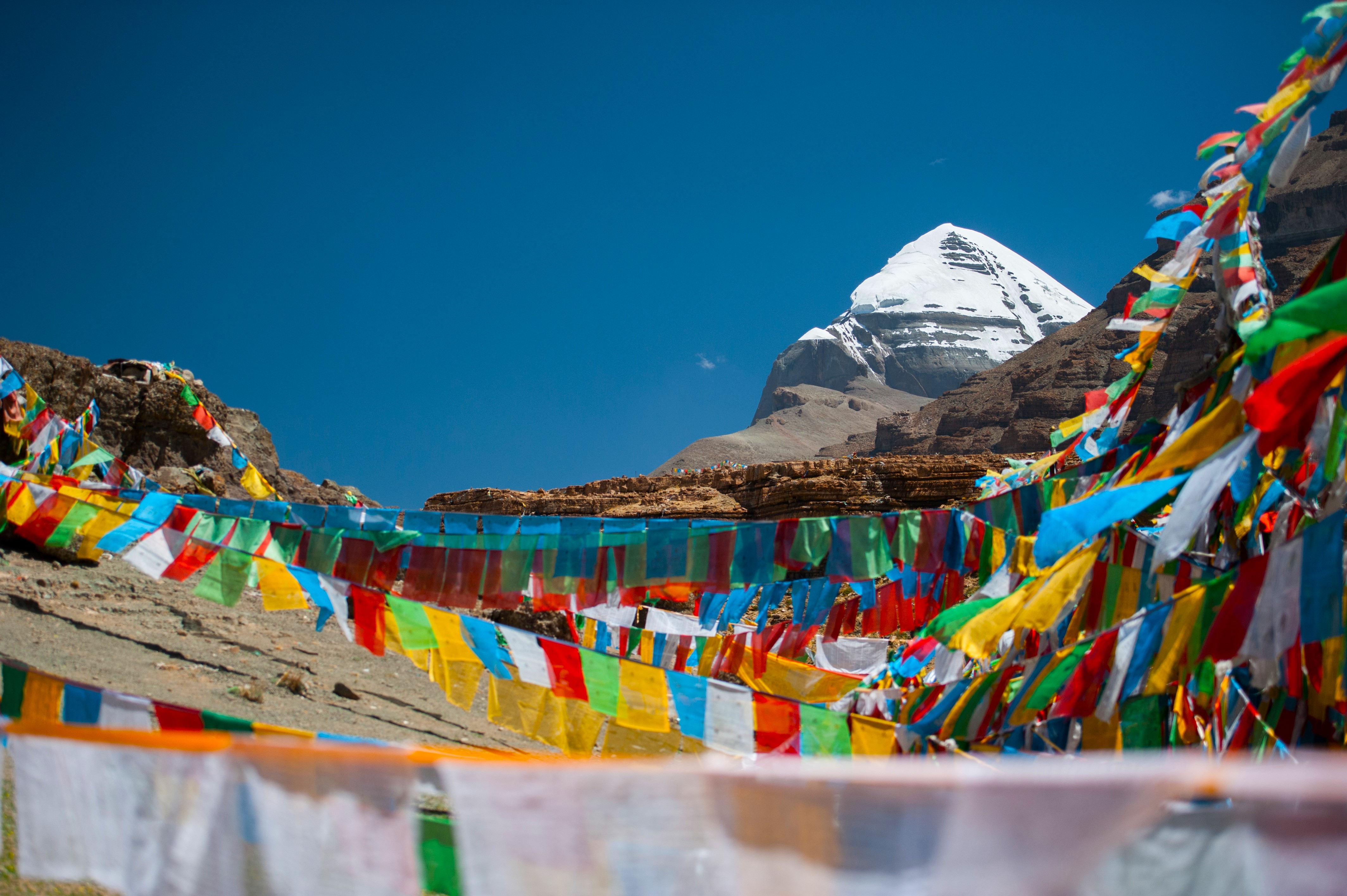
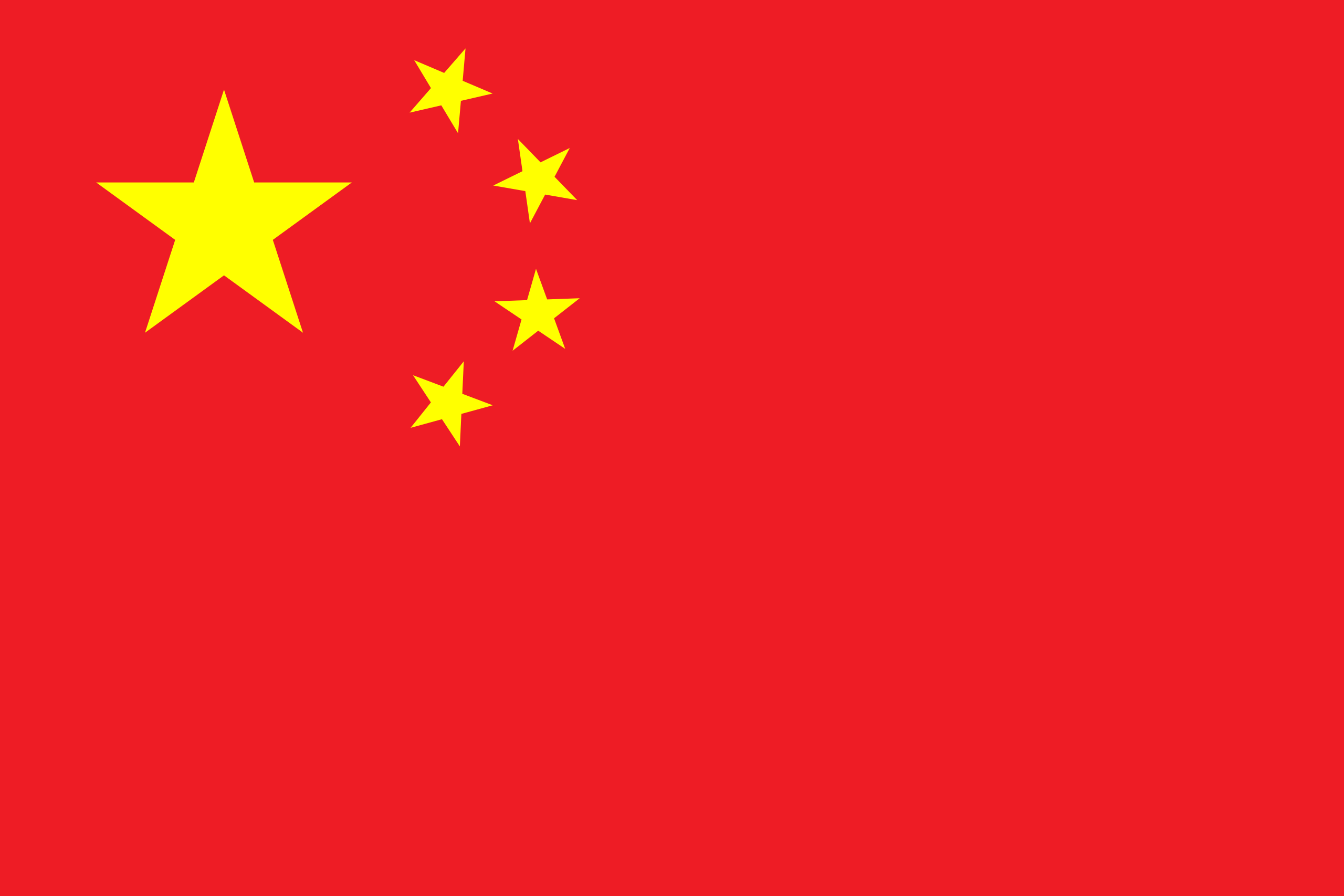 Tibet
Tibet 